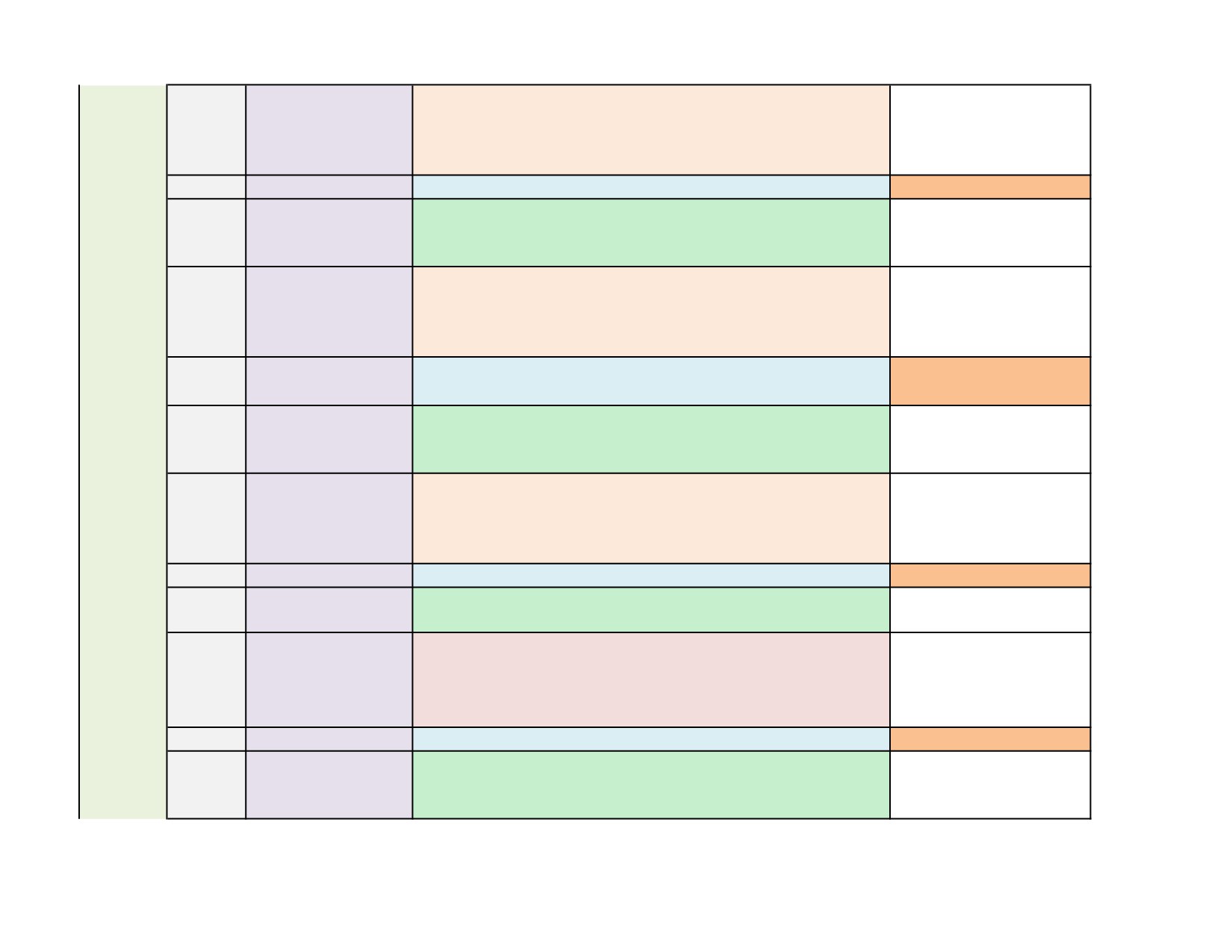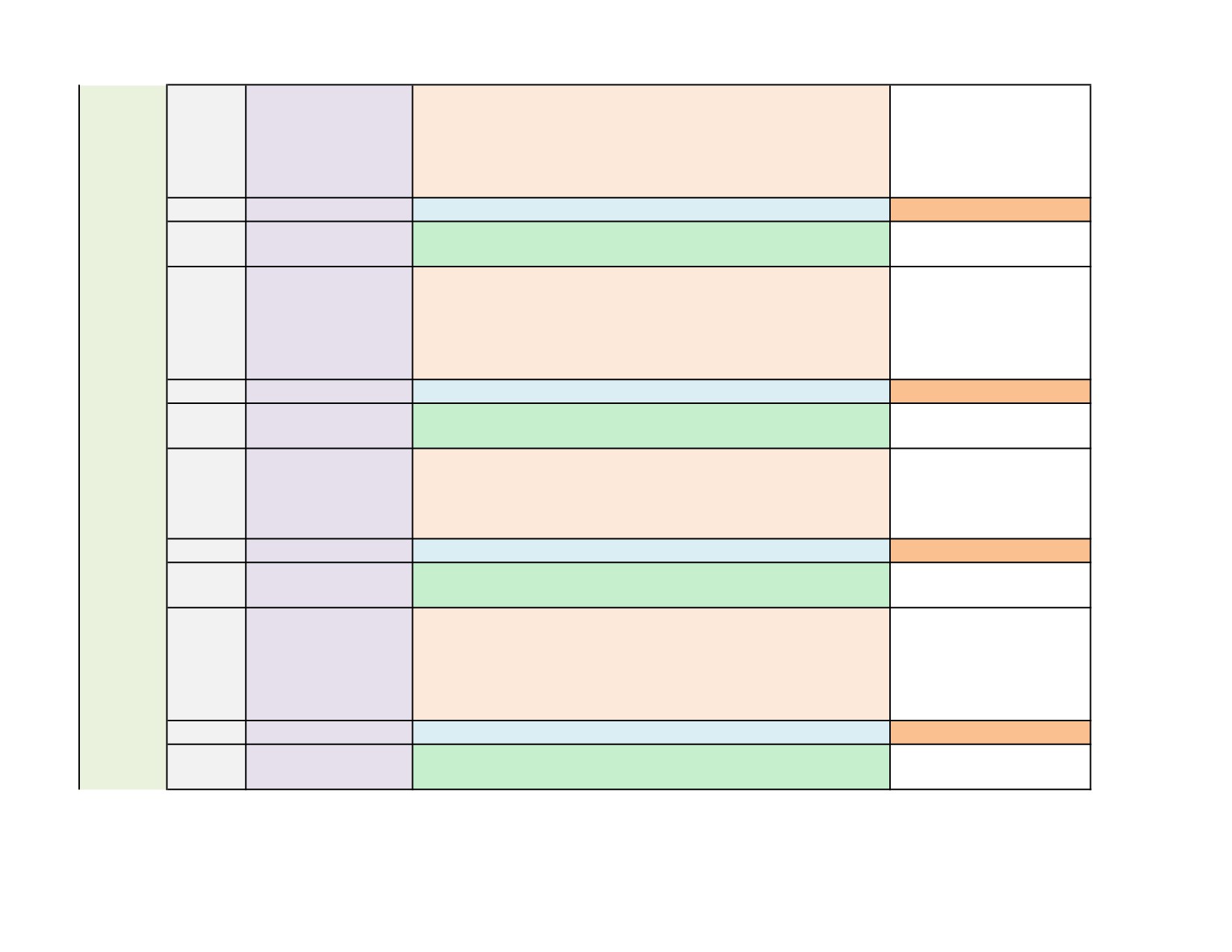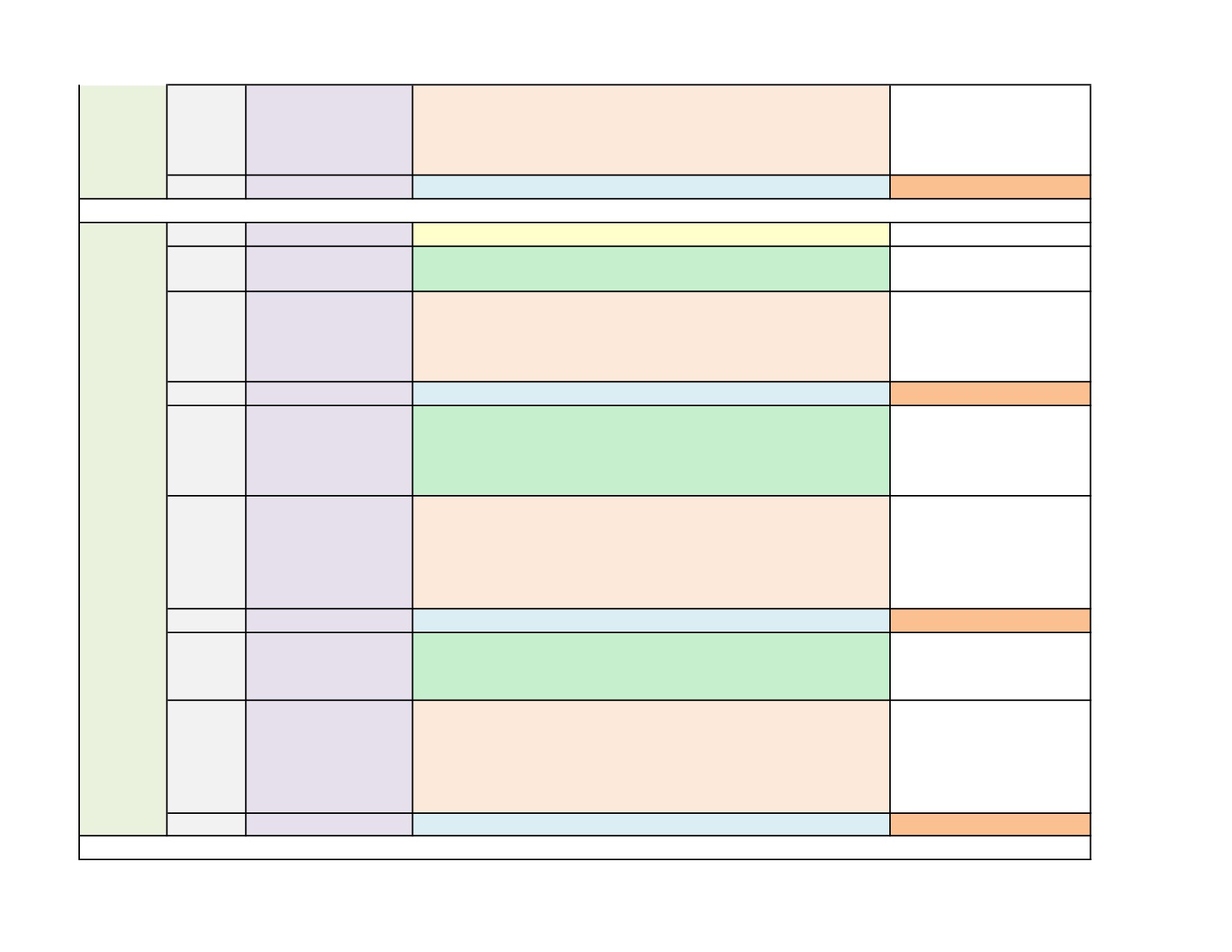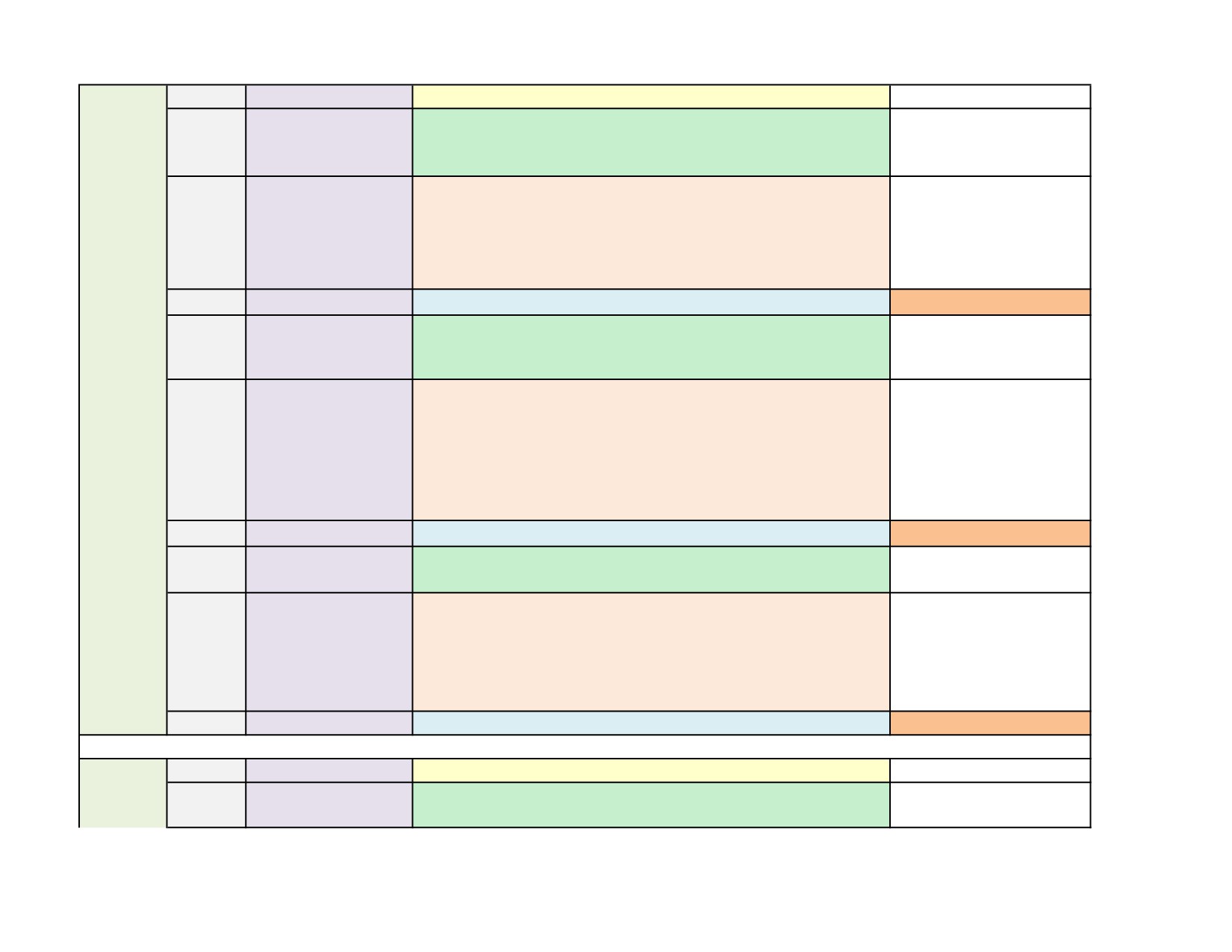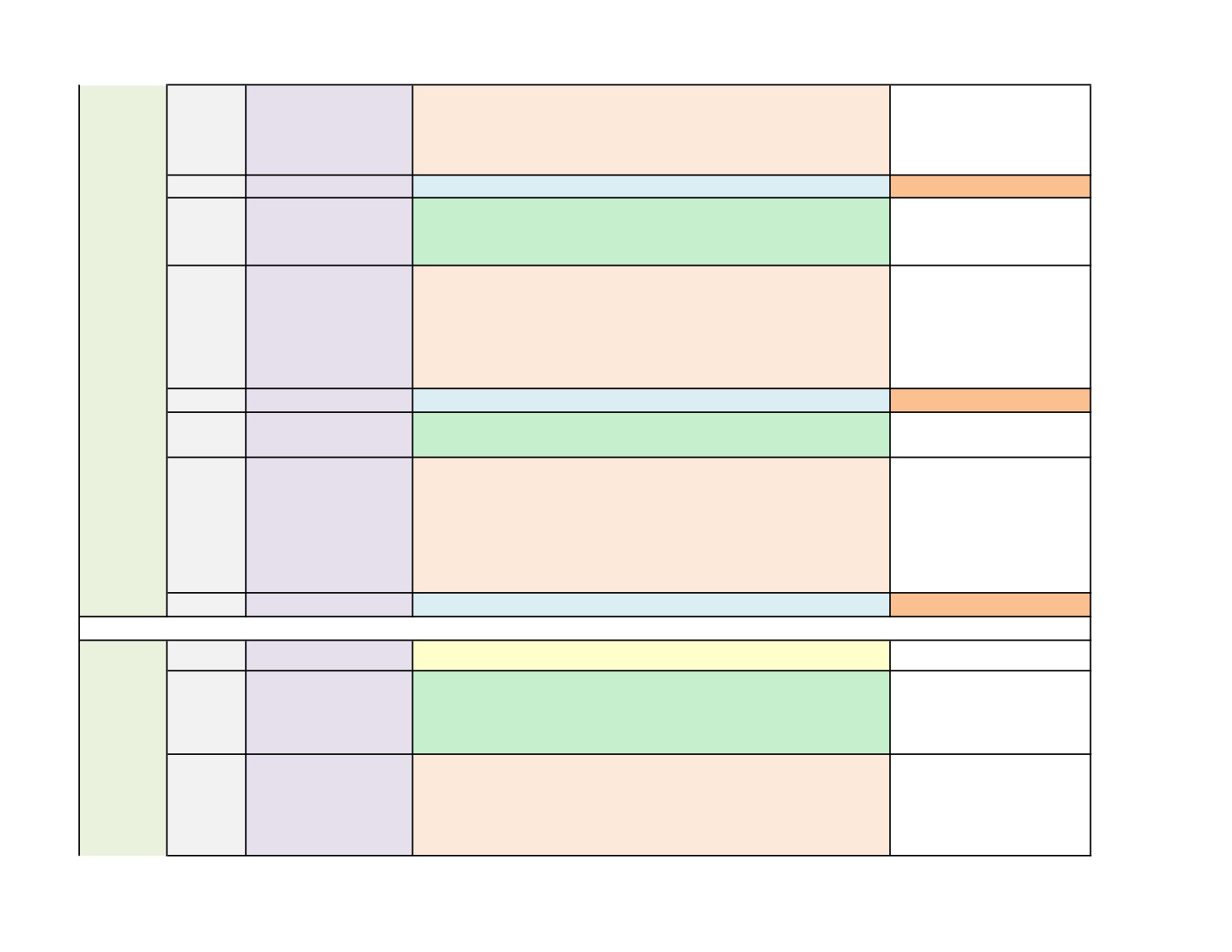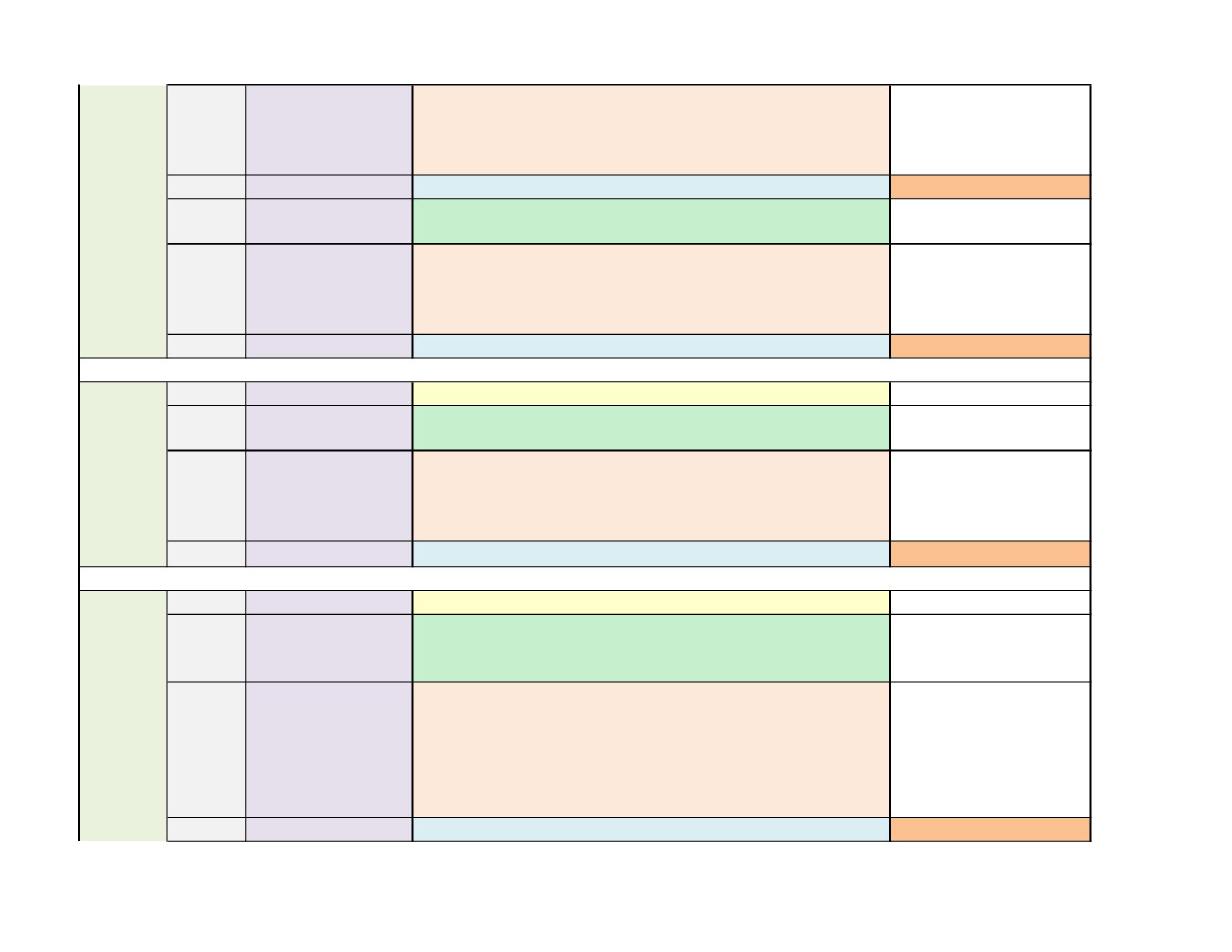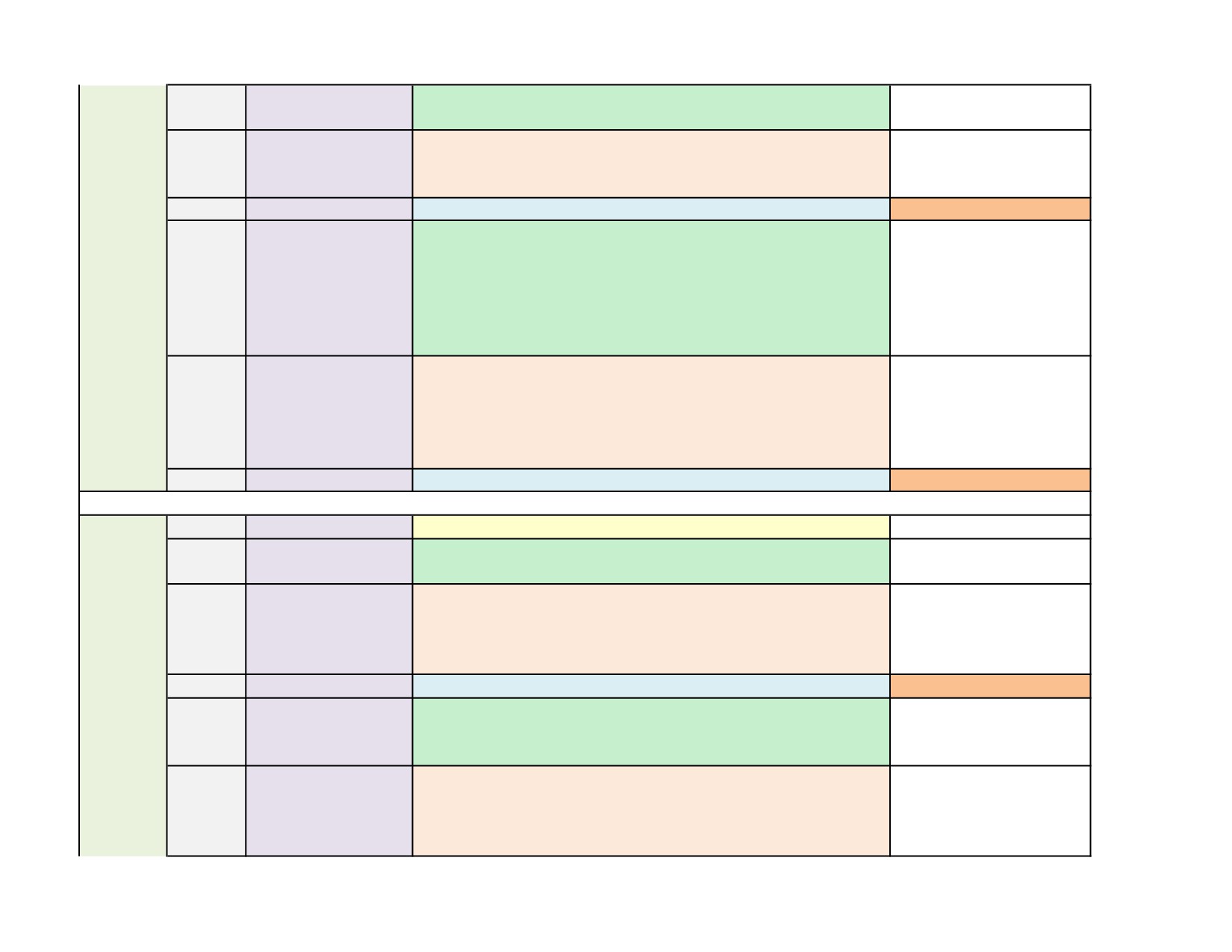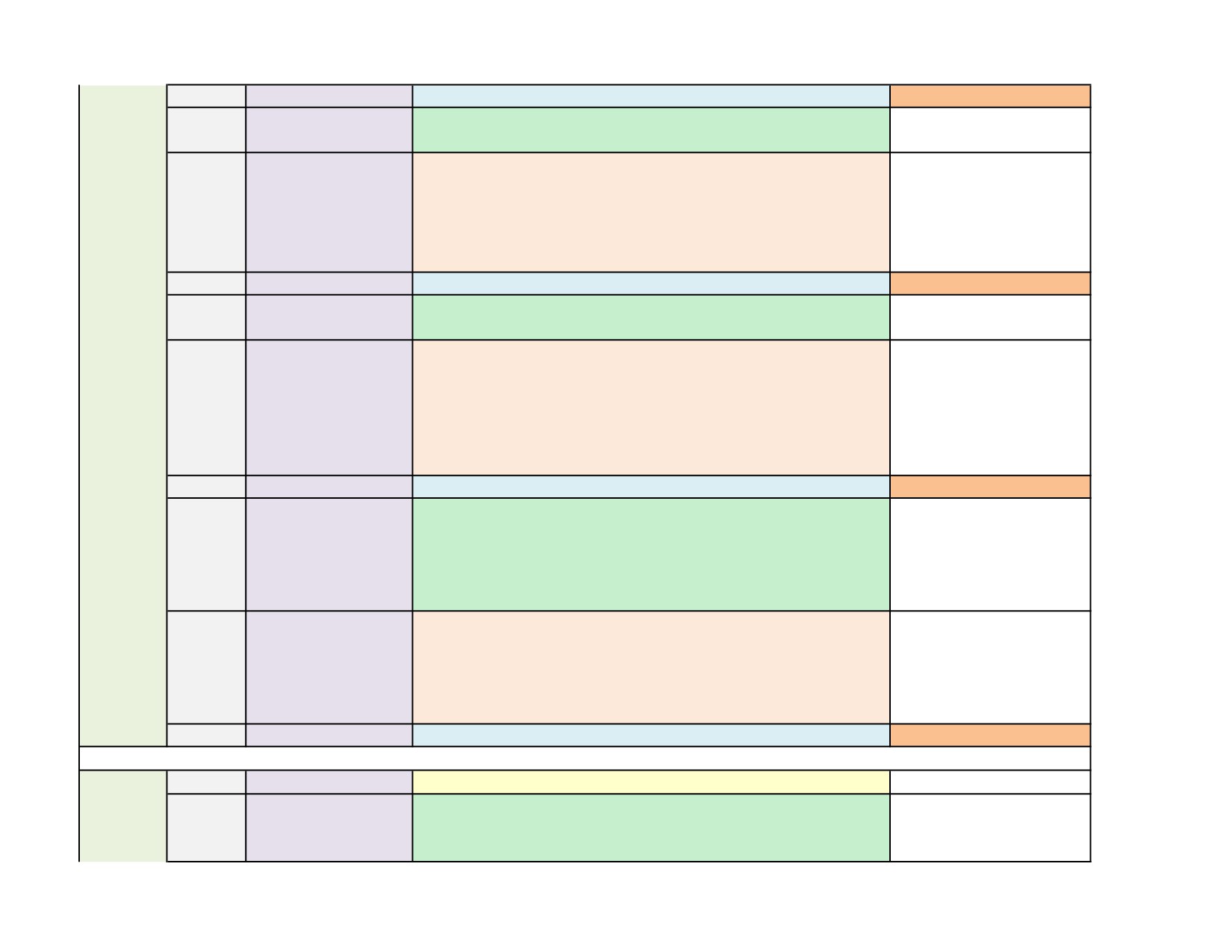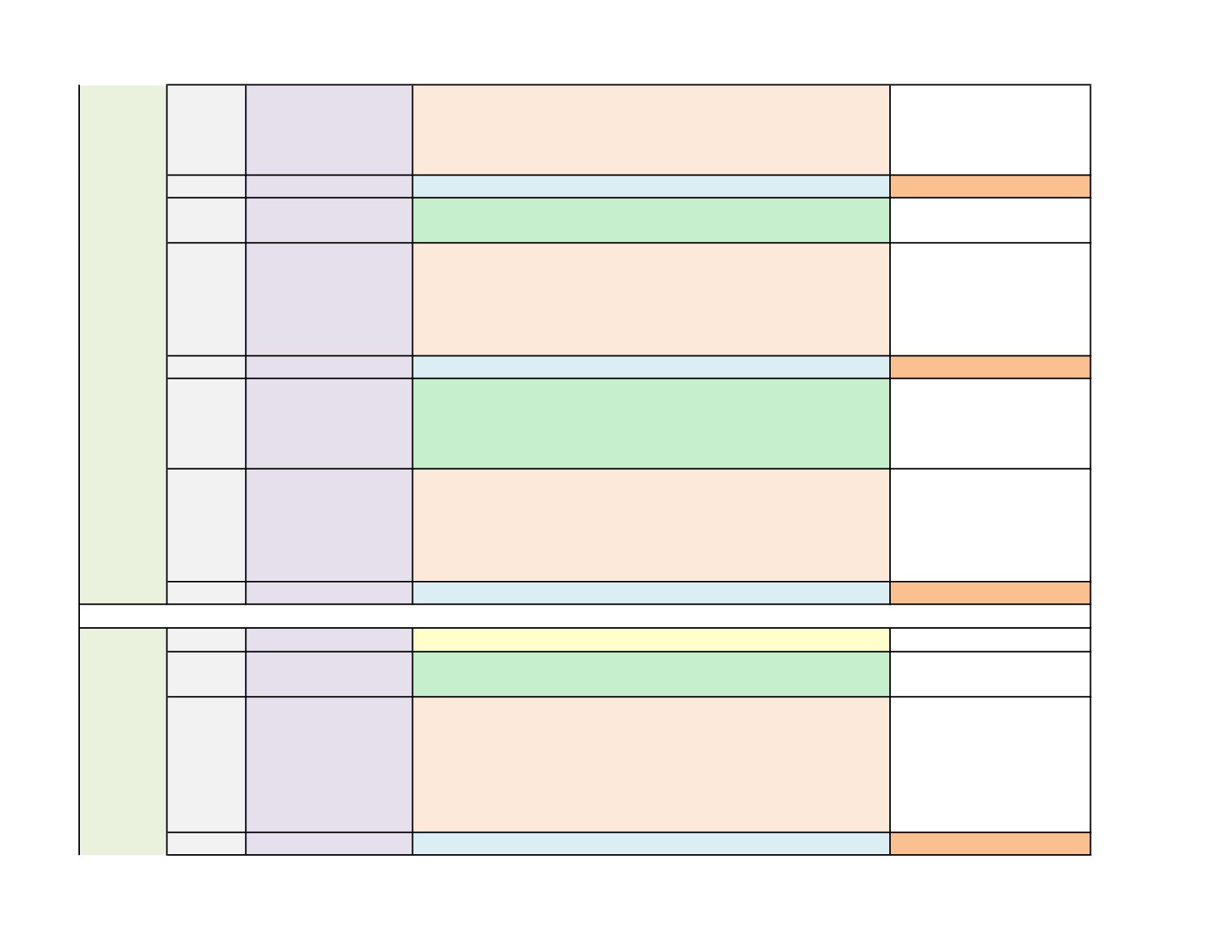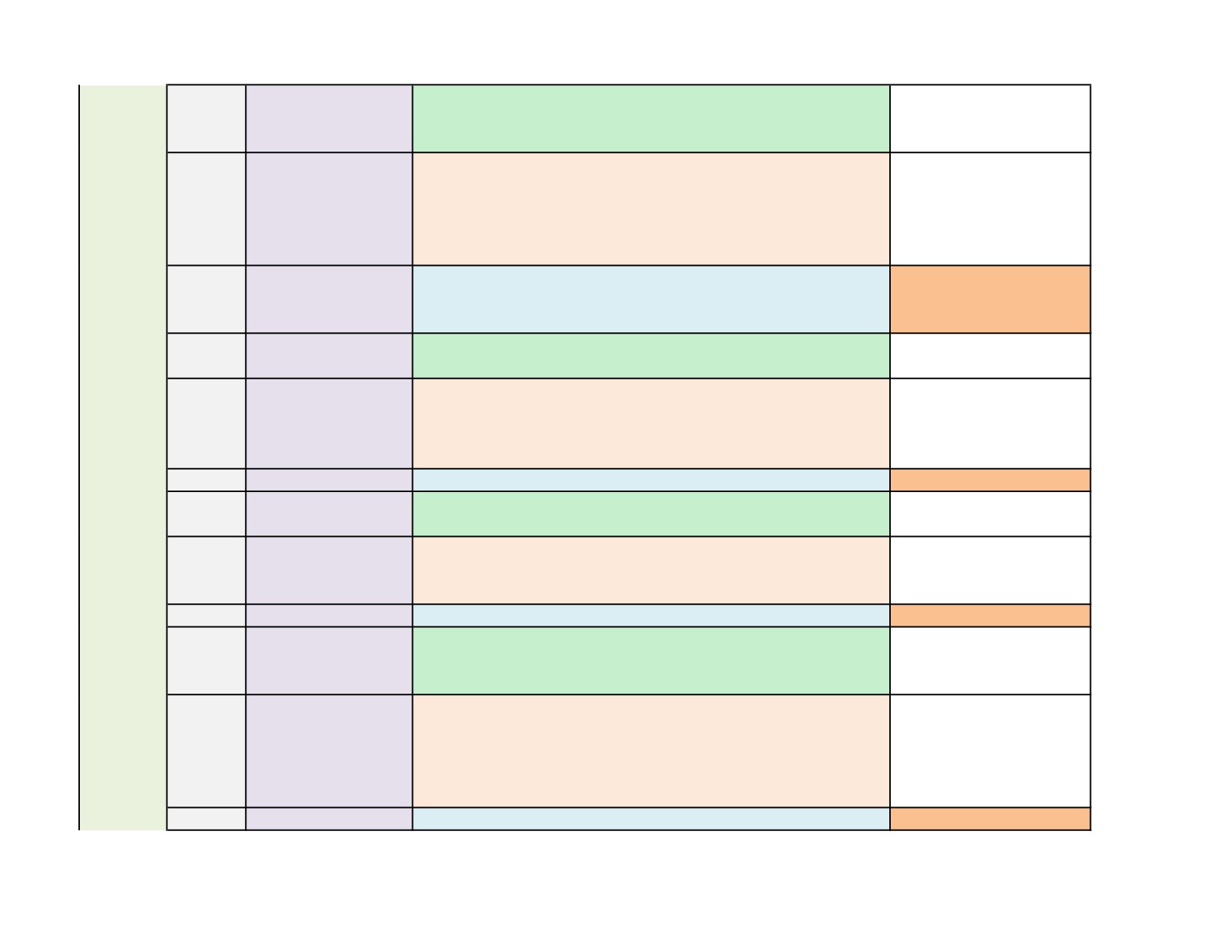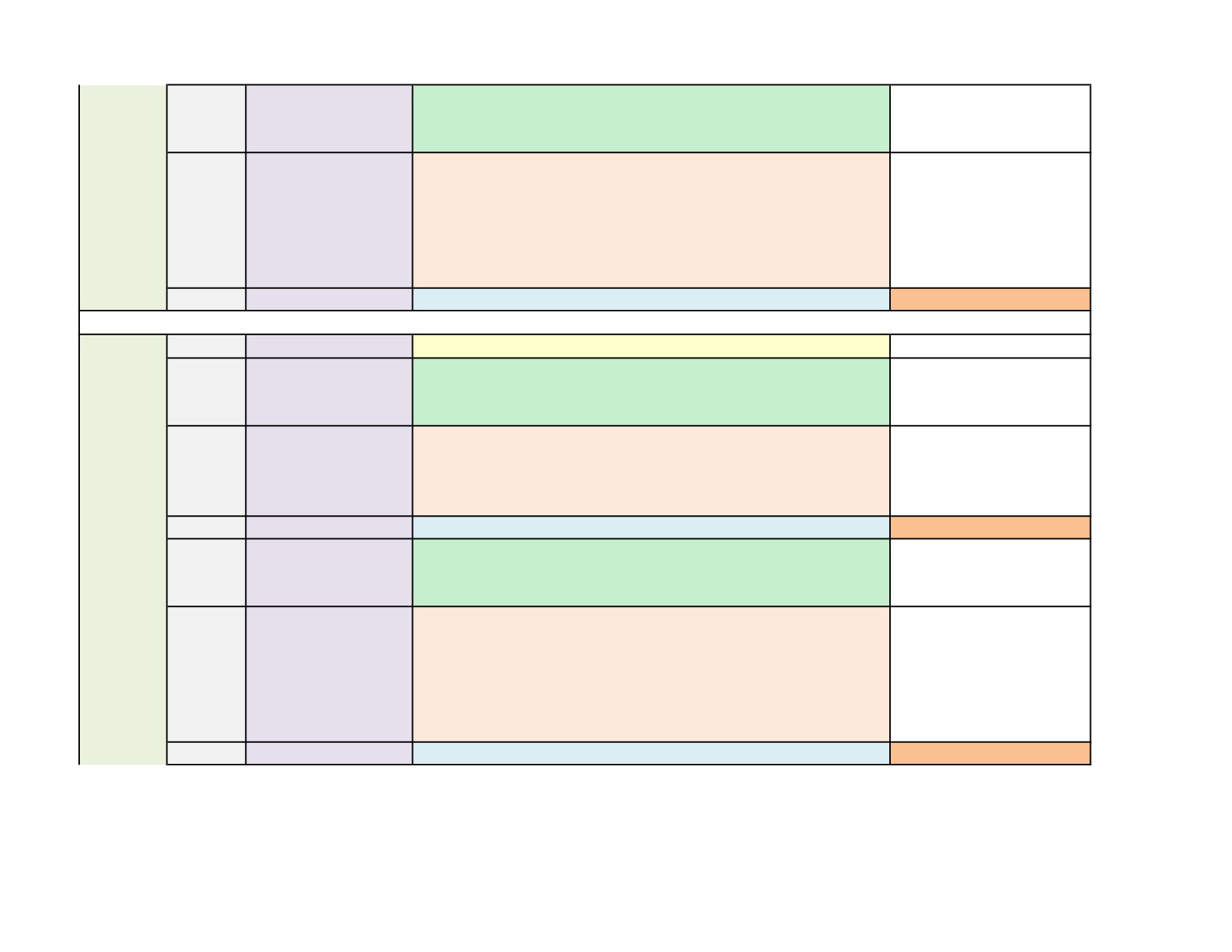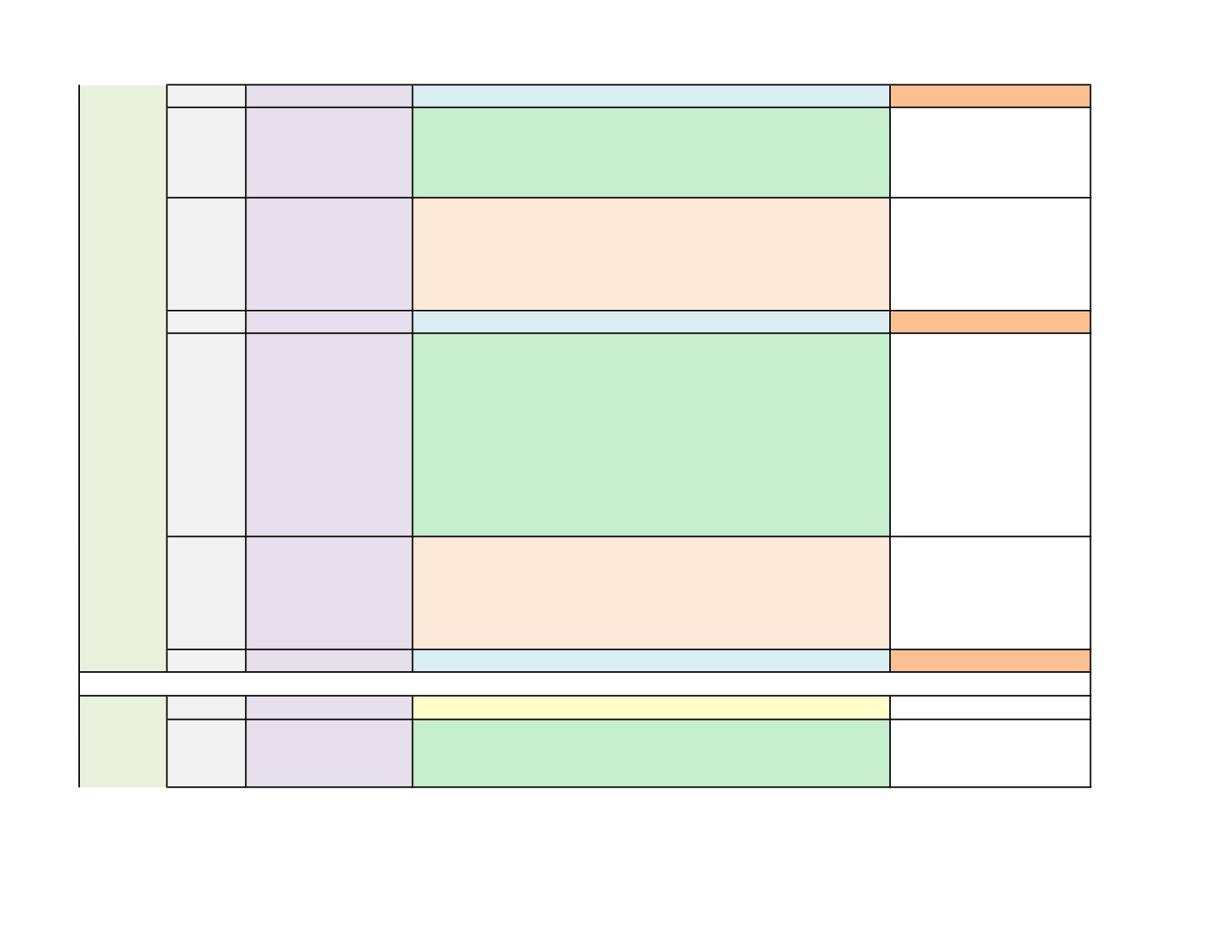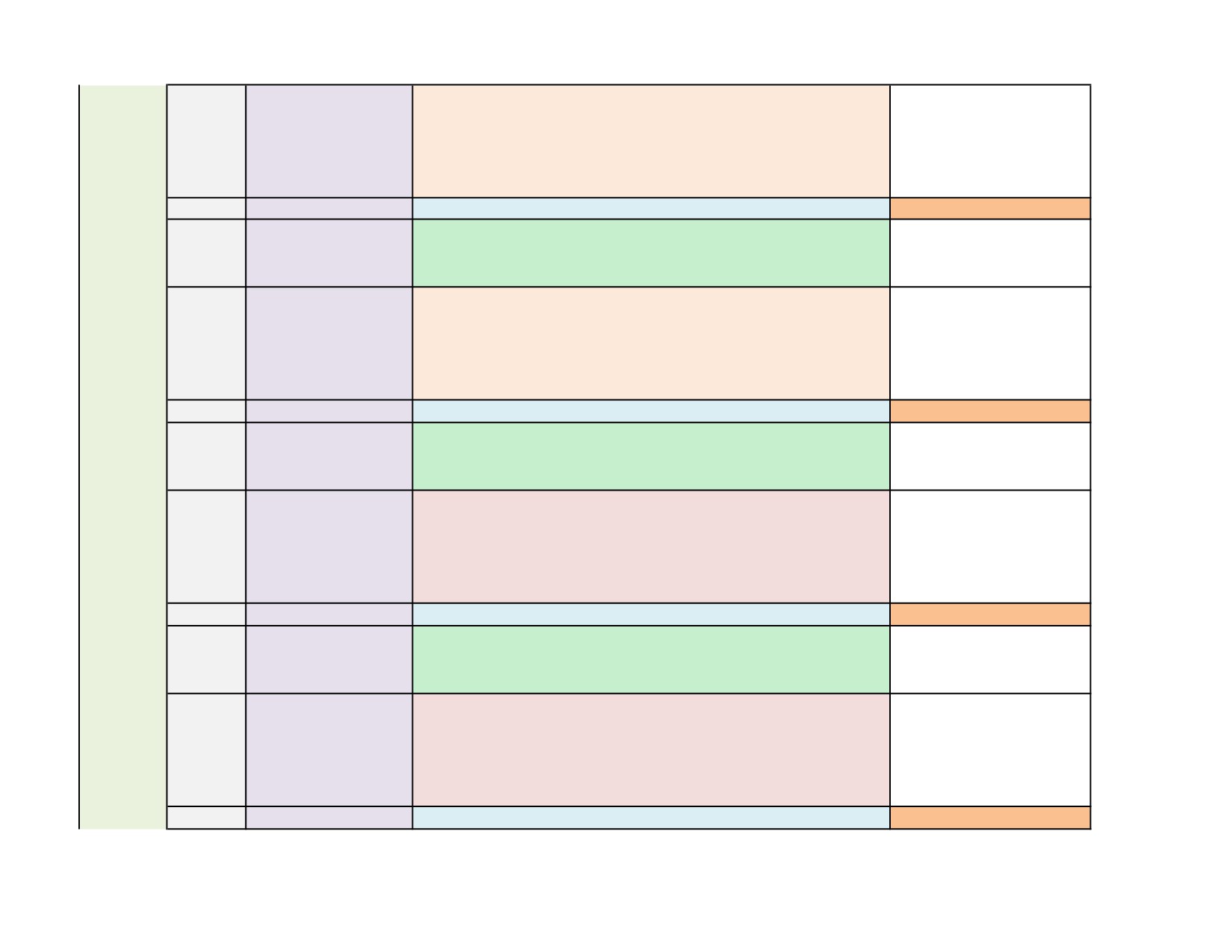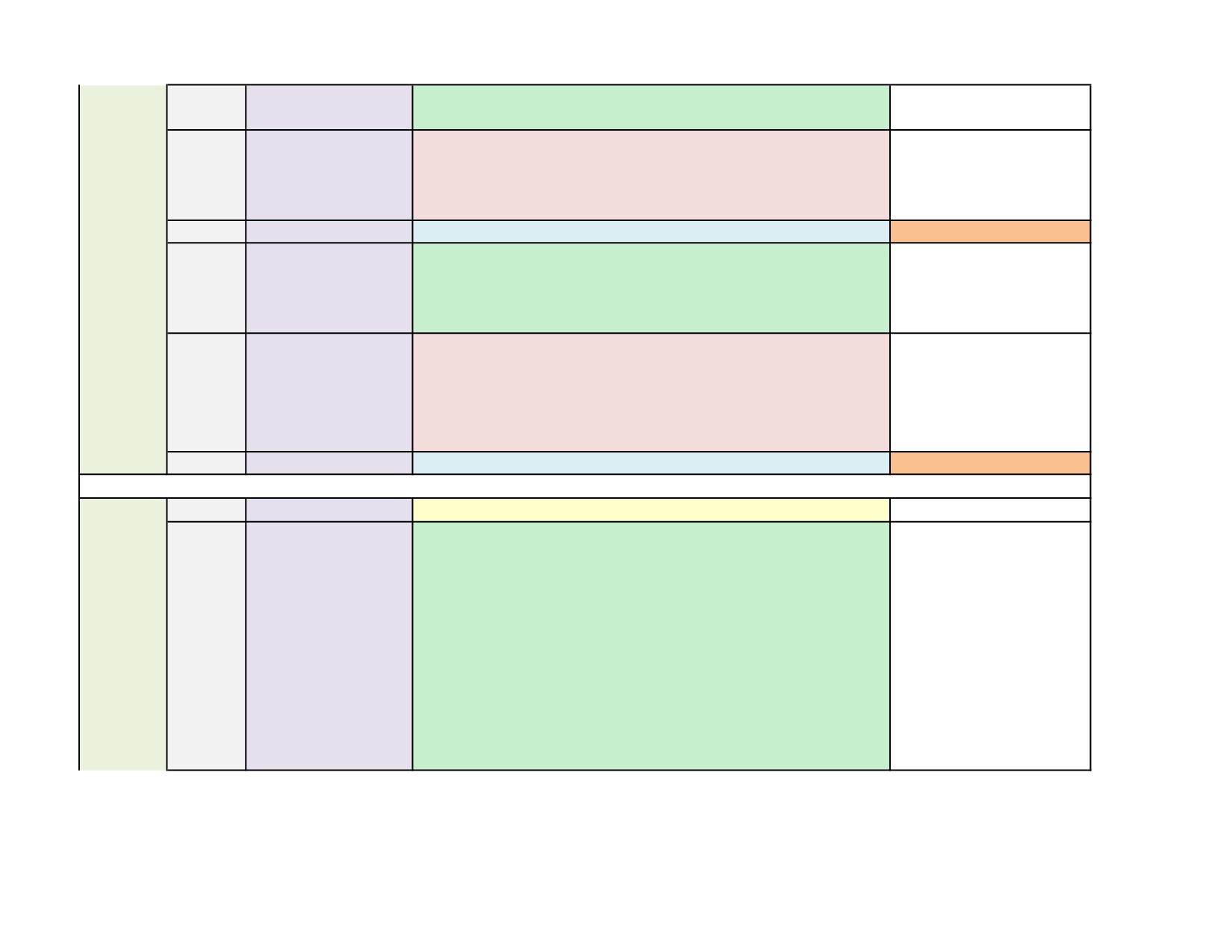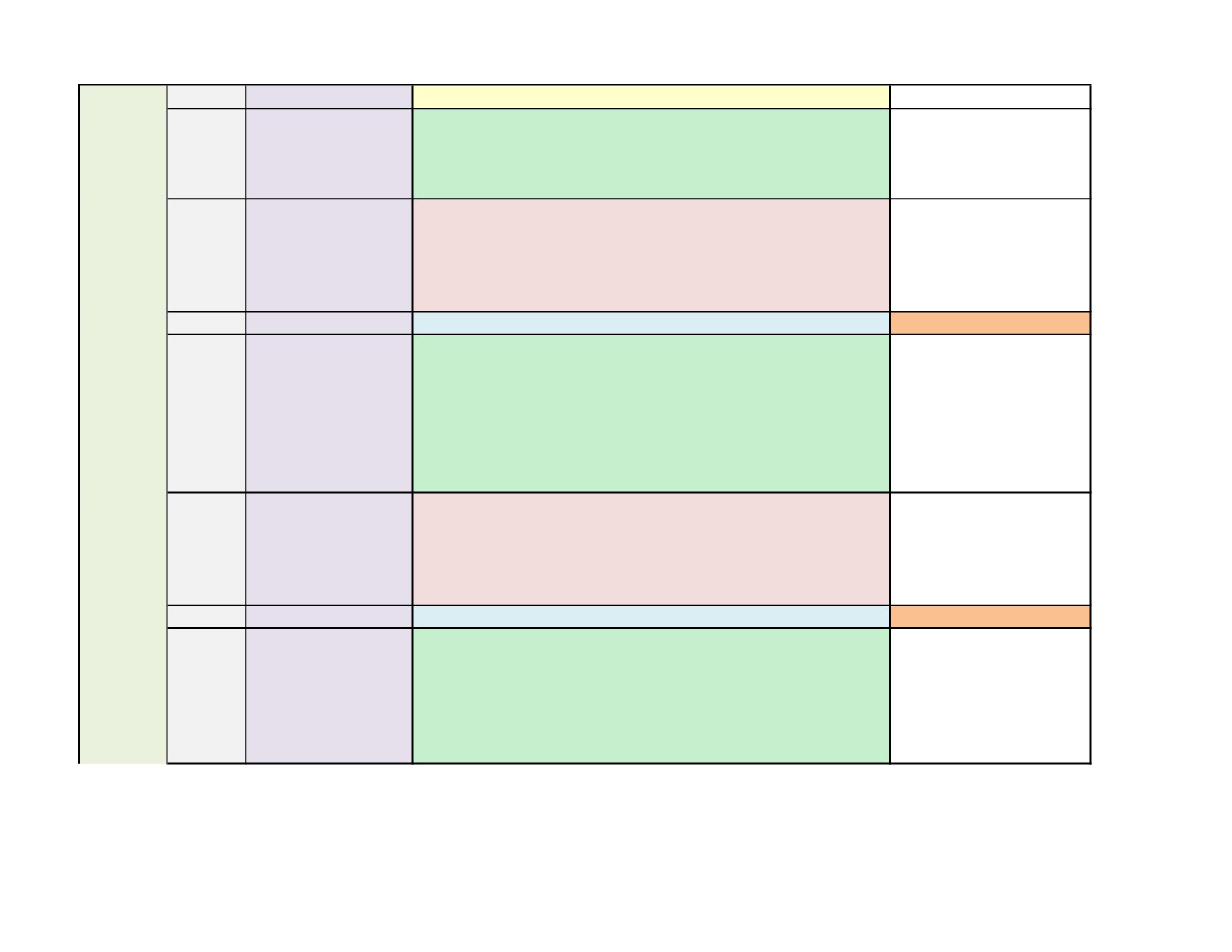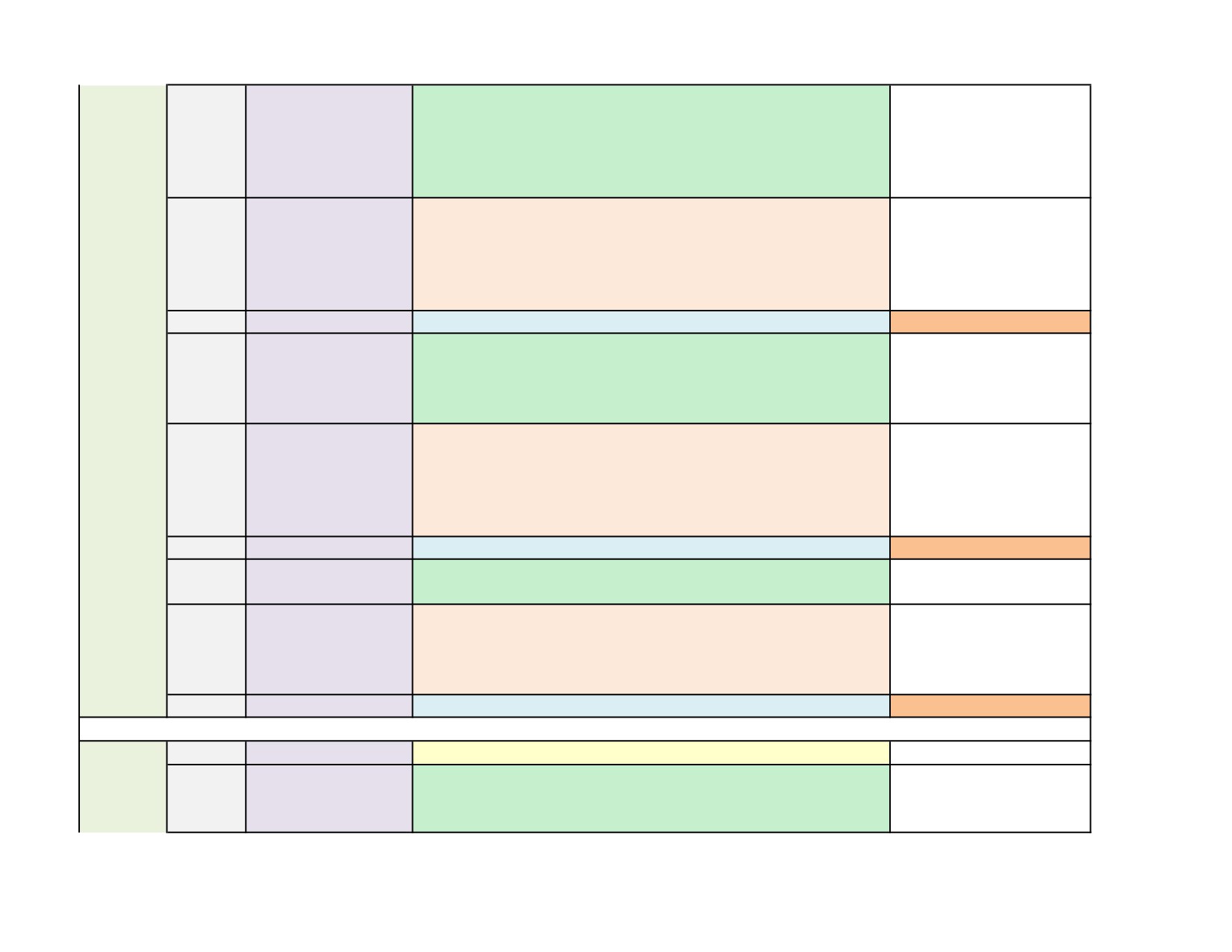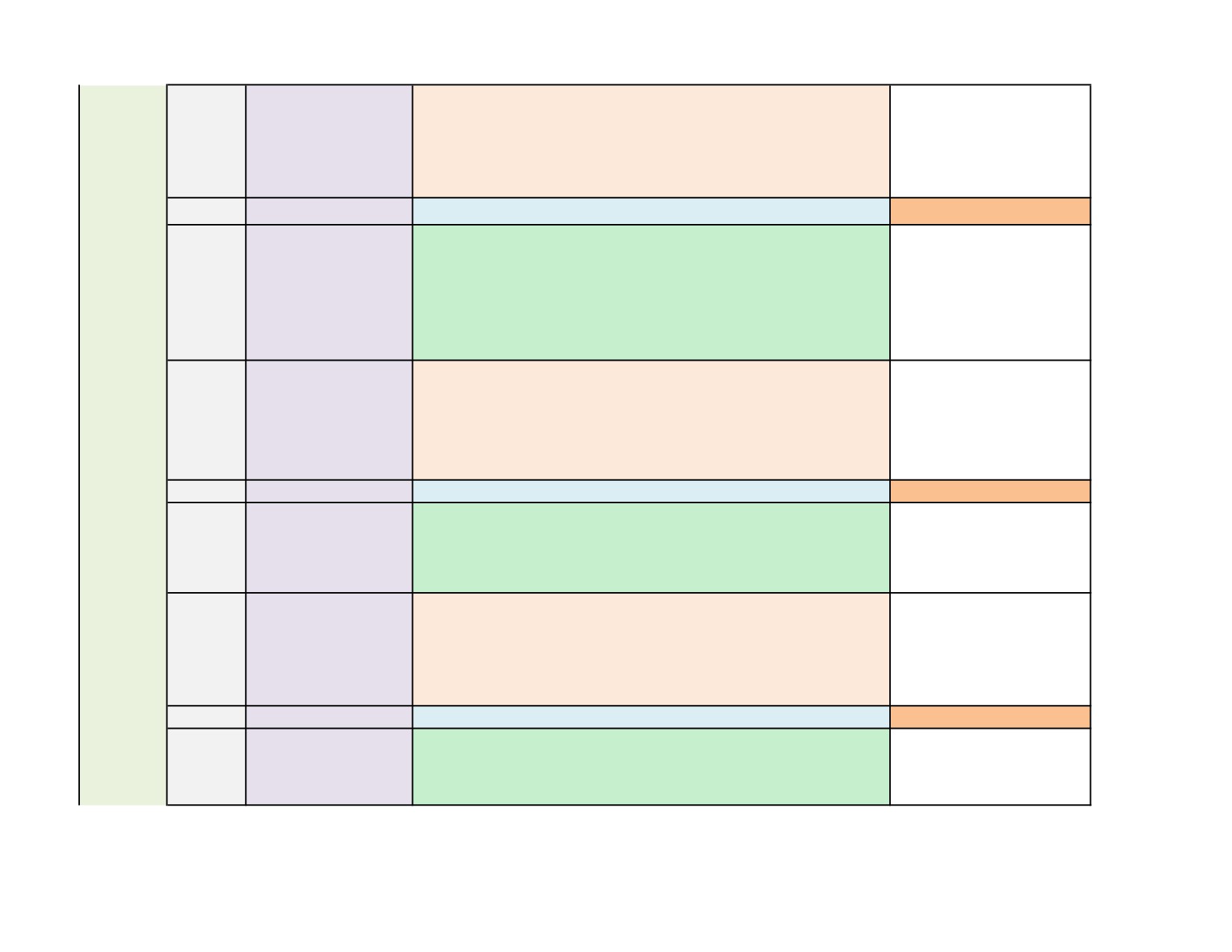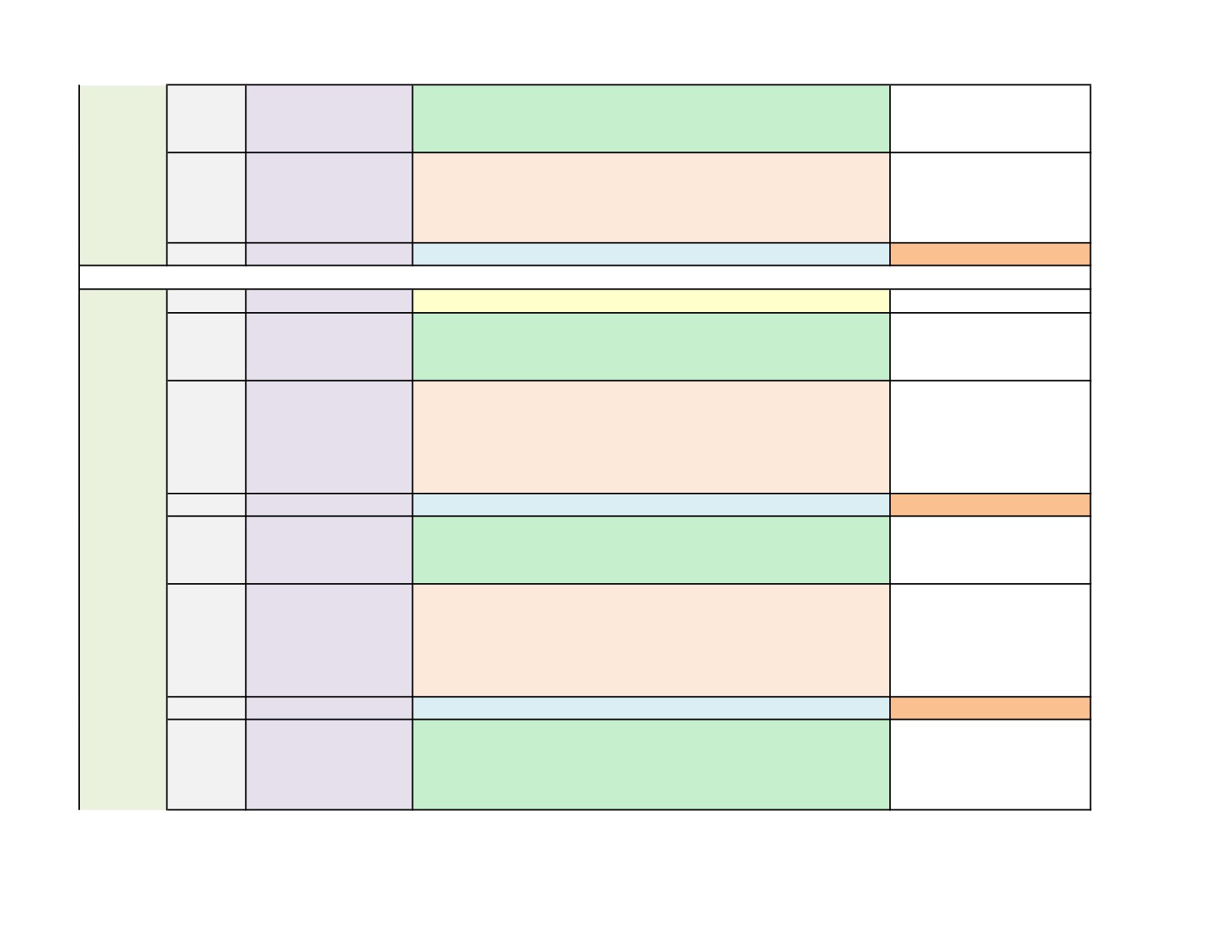CBME Curriculum AMCH
Pathology Phase I MBBS Lesson Plan
Topic No.
Lec.No.
Comp. No.
Titles: Topic, Competency with SLO & Lesson
Teaching Methodology
1
topic
Introduction to Pathology
PA 1.1, 1.2, 1.3
Describe the role of a pathologist in diagnosis and management of
disease
Enumerate common definitions and terms used in Pathology
Describe the history and evolution of Pathology
PA1.1, 1.2, 1.3/SLO
1. What is Pathology
2. Evolution of Pathology
3. Role of Pathologist in Diagnosis of disease
1
Introduction to Pathology
Lecture
2
topic
Cell Injury & Adaptation
PA 2.1,2.2
Demonstrate knowledge of the causes,
mechanisms, types and effects of cell injury and
their clinical significance
Describe the etiology of cell injury. Distinguish between reversible-
irreversible injury: mechanisms; morphology of cell injury
PA 2.1, 2.2/SLO
1.Causes and types of Cell injury
2. Biochemical pathways involved in Cell Injury
3. Morphology of Cell injury
2
Cell Injury
Lecture
PA 2.4
Describe and discuss Cell death- types,
mechanisms, necrosis, apoptosis
(basic as contrasted with necrosis), autolysis
PA 2.4/SLO
1. Types of Cell Death
2. Types of Necrosis
3. Mechanism of Necrosis
3
Cell Death - Necrosis
Seminar
PA 2.3, 2.5
Intracellular accumulation of fats, proteins,
carbohydrates, pigments
Describe and discuss pathologic calcifications, gangrene
PA 2.3, 2.5/SLO
1. Types of Intracellular Accumulations
2. Types of Pathologic calcification
3. Types of Gangrene
4
Intracellular Accumulations, Pigments, Pathologic
Lecture
calcifications
PA 2.6
Describe and discuss cellular adaptations:
atrophy, hypertrophy, hyperplasia, metaplasia,
dysplasia
PA 2.6/SLO
1. Types of Cellular Adaptations
2. Types of Metaplasia
3. Significance of Dysplasia
5
Cellular Adaptations
Lecture
PA 2.7
Describe and discuss the mechanisms of
cellular aging and apoptosis
PA 2.7/SLO
1. Pathways involved in Apoptosis
2. Definition of Necroptosis
3. Significane of Cellular Ageing
6,7
Cell Death - Apoptosis, Necroptosis & Cellular aging
Lecture
PA 2.8
Identify and describe various forms of cell injuries, their
manifestations and consequences in gross and microscopic
specimens
PA 2.8/SLO
1. Types of Cell Injuries
2. Gross & Microscopy of Reversible Cell Injury
3. Gross & Microscopy of Irreversible Cell Injury
8,9,10.11
Cell Injury
DOAP
3
topic
Amyloidosis
PA 3.1
Describe the pathogenesis and pathology
of amyloidosis
PA 3.1/SLO
1. Define Amyloidosis
2. Pathogenesis & classifcation of Amyloidosis
3. Properties of Amyloid Proteins
12
Amyloidosis
Lecture
PA 3.2
Identify and describe amyloidosis in a pathology
specimen
PA 3.2/SLO
1. Organs affected by Amyloidosis
2. Compsition & Types of Amyliod
3. Gross & Microscopy of Amyloidosis
13,14
Amyloidosis
DOAP
4
topic
Inflammation
PA 4.1
Define and describe the general features of acute
and chronic inflammation including stimuli,
vascular and cellular events
PA 4.1/SLO
1. Define Inflammation
2. Difference between Acute & Chronic Inflammation
3. Vascular events in Inflammation
4. Cellular events in Inflammation
15,16
Vascular & Cellular events of Inflammation
Tutorial,
Lecture
PA 4.2
Enumerate and describe the mediators of
acute inflammation
PA 4.2/SLO
1. Types of Mediators
2. Various Pathways of Complement
3. Role of Arachidonic acid metabolites in Inflammation
17,18
Mediators of Inflammation
Lecture
PA 4.3
Define and describe chronic inflammation
including causes, types, non-specific and
granulomatous; and enumerate examples of each
PA 4.3/SLO
1. Causes of Chronic Inflammation
2. Morphologuical features of Chronic Inflammation
3. Cells & Mediators of ChronicInflammation
4. Granulomatous Inflammation
19
Chronic Inflammation
Seminar
PA 4.4
Identify and describe acute and chronic
inflammation in gross and microscopic specimens
PA 4.4/SLO
1. Differences between Acute & Chronic Inflammation
2. Morphologic Patterns of Acute & Chronic Inflammation
3. Gross & Microscopy of Acute & Chronic Inflammation
20,21,
Inflammation
DOAP
22,23
5
topic
Healing and Repair
PA 5.1
Define and describe the process of repair and
regeneration including wound healing and its types
PA 5.1/SLO
1. Types of Healing
2. Repir by Primary Healing
3. Repair by secondary Healing
4. Factors influencing Wound Heaking
24,25
Healing & Repair
Lecture
6
topic
Hemodynamic Disorders
PA 6.1,6.2
Define and describe edema, its types,
pathogenesis and clinical correlations
Define and describe hyperemia, congestion,
hemorrhage
PA 6.1, 6.2/SLO
1. Pathophysiology of Edema
2. Types of Edema
3. Define CVC lung/liver
26
Edema, Congestion, Hyperemia, Hemorrhage
Seminar
PA 6.3
Define and describe shock, its pathogenesis
and its stages
PA 6.3/SLO
1. Types of Shock
2. Pathogenesis of Septic Shock
3. Stages of Shock
27,28
Shock
IL
PA 6.4, 21.1
Define and describe normal haemostasis and
the etiopathogenesis and consequences of
thrombosis
PA 6.4, 21.1/SLO
1. Pathways in Normal Hemostasis
2. Types of Thrombosis
3. Difference between Antemortem & Postmortem clot
4. Fate of Thrombus
29,30
Hemostasis & Thrombosis
SDL, Lecture
PA 6.5,6.6
Define and describe embolism and its causes and common types
Define and describe Ischaemia/infarction its
types, etiology, morphologic changes and
clinical effects
PA 6.5, 6.6/SLO
1. Define Embolism
2. Types of Embolism
3. Definition & types of Infarction
31
Embolism & Infarction
Lecture
PA 6.7
Identify and describe the gross and microscopic
features of infarction in a pathologic specimen
PA 6.7/SLO
1. Types of Infarcts
2. Manifestation of Infarction in various Organs
3. Gross & Microscopy of Infarction
32,33
Hemodynamic Disorders
DOAP
7
topic
Neoplasia
PA 7.1
Define and classify neoplasia. Describe the
characteristics of neoplasia including gross,
microscopy, biologic, behaviour and spread.
Differentiate between benign from maignant
neoplams
PA 7.1/SLO
1. Define Neoplasis
2. Difference between Benign & Malignant Neoplasms
3. Route of Spread of Neoplasm
34
Introduction to Neoplasia
Lecture
PA 7.2
Describe the molecular basis of cancer
PA 7.2/SLO
1. Cellular & Molecular Hallmarks of Cancer
2. Protooncogenes
3. Tumor Supressor Genes
4. Metastatic Cascade
35,36
Molecular basis of Cancer
Lecture
PA 7.3
Enumerate carcinogens and describe the
process of carcinogenesis
PA 7.3/SLO
1. Types of Carcinogens
2. Steps involved in Chemiacal Carcinogenesis
3. Microbial Carcinogenesis
4. Radiation Carcinogenesis
37
Carcinogenesis
Lecture
PA 7.4
Describe the effects of tumor on the host
including paraneoplastic syndrome
PA 7.4/SLO
1. Clinical aspects of Neoplasia
2. Define Paraneoplastic Syndrome
3. Paraneoplastic Manifestations in Small cell Carcinoma
38
Effects of tumor on the host including Paraneoplastic
Lecture
PA7.5
Describe immunology and the immune
response to cancer
PA7.5/SLO
1. Define Immune Surveillence & Escape
2. Role of NK cells in Tumor
3. Tumor infiltrating Lymphocytes
39,40
Immune Response to Cancer
Tutorial, SDL
8
topic
Basic Diagnostic Cytology
PA 8.1
Describe the diagnostic role of cytology and
its application in clinical care
PA 8.1/SLO
1. Define Cytopathology
2. Cytopathology of Thyroid Lesions
3. Cytopathology in Breast Lesions
41
Introduction to Cytology
Lecture
PA 8.2
Describe the basis of exfoliative cytology
including the technique & stains used
PA 8.2/SLO
1. Define Exfoliative Cytology
2. Role of Exfoliative Cytology in diagnosis of CA Cervix
3. Bronchoalveolar Lavage
42,43
Exfoliative Cytology
Lecture,
PA 8.3
Observe a diagnostic cytology and its staining
and interpret the specimen
PA 8.3/SLO
1. Stains commonly used in Diagnostic Cytology
2. Steps in Hematoxylin & Eosin Staining
3. Interpretation of Cytology Smear
44-55
Cytology slides, staining procedure & interpretation
DOAP
9
topic
Immunopathology & AIDS
PA 9.1
Describe the principles and mechanisms
involved in immunity
PA 9.1/SLO
1. Define of Immunity
2. Types of Immunity
3. Cells of Immune System
4. Tiisues of Immune System
56,57
Introduction to Immunology
IL
PA 9.2
Describe the mechanism of hypersensitivity
reactions
PA 9.2/SLO
1. Define Hypersensitivity Reactions
2. Classification of Hypersensitivity Reactions
3. Type I Hypersensitivity Reaction
4. Type IV Hypersensitivity Reaction
58-60
Hypersensitivity Reactions
Lecture, DOAP
PA 9.3
Describe the HLA system and the immune
principles involved in transplant and mechanism
of transplant rejection
PA 9.3/SLO
1. Define HLA
2. Types of HLA
3. Cells Expressing HLA Class I & II
4. Role of HLA in Transplat rejection
61
HLA system, Transplant rejection
Seminar
PA 9.4
Define autoimmunity. Enumerate autoimmune
disorders
PA 9.4/SLO
1. Define Autoimmunity
2. Immunological Tolerance
3. General Principles of Autoiimunity
4. Enumerate Autoimmune Disorders
62
Autoimmunity
Lecture
PA 9.5
Define and describe the pathogenesis of
systemic Lupus Erythematosus
PA 9.5/SLO
1. Criteria For Diagnosis of SLE
2. Spectrum of Antibodies in SLE
3. Lupus Nephritis
63
SLE
Lecture
PA 9.6
Define and describe the pathogenesis and
pathology of HIV and AIDS
PA 9.6/SLO
1. Types of HIV
2. Mechanism of T cell Depletion in HIV
3. Lifecycle of HIV
4. Infections & Tumors in HIV
64
AIDS
Lecture
PA 9.7
Define and describe the pathogenesis of
other common autoimmune diseases
PA 9.7/SLO
1. Enumarate Autoimmune Disorders
2. Antibody profile in Sjogren Syndrone
3. Types of Systemic Sclerosis
65
Other Autoimmune Disorders
Tutorial
10
topic
Infection & Infestations
PA 10.1
Define and describe the pathogenesis and
pathology of malaria
PA 10.1/SLO
1. Name of Parasites causing Malaria
2. What are the phases of Malarial Infection
3. Pathogenesis of Malarial Infection
66
Malaria
Seminar
PA 10.2, 10.3
Define and describe the pathogenesis
and pathology of cysticercosis
Define and describe the pathogenesis and pathology of leprosy
PA 10.2, 10.3/SLO
1. Types of Leprosy and its causative organism
2. Neurocysticercosis
3. Lepra cells
4. Special stain for Lepra bacili
67
Leprosy & Cysticercosis
Seminar
PA 10.4
Define and describe the pathogenesis and
pathology of common bacterial, viral, protozoal
and helminthic diseases
PA 10.4/SLO
1. How Microorganisms cause disease
2. Host Pathogen Interactions
3. Host damage by Organisms
4. Spectrum of Inflammatory response to Infection
68,69
Genereal Features of infections
Lecture,
11
topic
Genetic & Pediatric Diseases
PA 11.1
Describe the pathogenesis and features of
common cytogenetic abnormalities and mutations
in childhood
PA 11.1/SLO
1. Autosomes, Allosomes
2. Down Syndrome
3. Klinefelter Syndrome
4. Turner Syndrome
70,71
CytoGenetics
SDL
PA 11.2
Describe the pathogenesis and pathology
of tumor and tumour- like conditions in infancy
and childhood
PA 11.2/SLO
1. Hamartoma
2. Choristoma
3. Hemangioma
4. Neuroblastoma
5. Wilms Tumor
72
Pediatric tumors
Lecture
PA 11.3
Describe the pathogenesis of common
storage disorders in infancy and childhood
PA 11.3/SLO
1. Types Of Storage Disorders
2. Tay Sachs Disease
3. Niemann Pick Disease
4. Gaucher Disease
73,74
Storage Disorders
Seminar, SDL
12
topic
Environmental & Nutritional Diseases
PA 12.1
Enumerate and describe the pathogenesis of
disorders caused by air pollution, tobacco and alcohol
PA 12.1/SLO
1. Outdoor & Indoor Airpollution
2. Health effects Of Tobacco
3. Metabolism & Health effects of Alcohol
75
Air pollution, Effects of Tobacco & Alcohol abuse
SDL
PA 12.2
Describe the pathogenesis of disorders
caused by protein calorie malnutrition and
starvation
PA 12.2/SLO
1. Marasmus
2. Kwashiorkor
3. Anrexia Nervosa
4. Bulimia Nervosa
76,77
PEM
SDL
PA 12.3
Describe the pathogenesis of obesity and
its consequences
PA 12.3/SLO
1. Define Obesity
2. Regulation of Energy Balance
3. BMI
4. Consequences of Obesity
5. Obesity & Cancer
78
Obesity
SDL
13
topic
Introduction to Hematology
PA 13.1,13.2
Describe hematopoiesis and extramedullary
hematopoiesis
Describe the role of anticoagulants in
hematology
PA 13.1/SLO
1. Sites Of Normal & Extramedullary Hematopoiesis
2. Color of Vials & Anticooagulants present in the same
3. Mechanism of Action of Anticooagulants
79
Normal Hematopoiesis, Anticoagulants
Seminar
PA 13.3,13.4
Define and classify anemia
Enumerate and describe the investigation of anemia
PA 13.3, 13.4/SLO
1. Definition of Anemia
2. Classification of Anemia
3. Lab diagnosis of Anemia
80
Introduction & investigations of Anemia
Lecture
PA 13.5
Perform, Identify and describe the peripheral
blood picture in anemia
PA 13.5/SLO
1. Procedure of doing Smear
2. Leishman's Stain for Peripheral Smear
3. Interpretation of Peripheral Smear
81,82
Peripheral smear
DOAP
14
Microcytic Anemia
PA 14.1, 14.2
Describe iron metabolism
Describe the etiology, investigations and differential diagnosis of
PA 14.1, 14.2/SLO
1. Iron absorption & Metabolism
2. Etiology of Iron Deficiency Anemia
3. Differential Diagnosis of Microcytic Hypochromic Anemia
4. Lab diagnosis of Iron Deficiency Anemia
83
MHA
IL
PA 14.3
Identify and describe the peripheral smear
in microcytic anemia
PA 14.3/SLO
1. Stains used in Peripheral Smear
2. Indication for Peripheral Smear
3. Interpret smear of MHA
84,85
MHA
DOAP
15
topic
Macrocytic Anemia
PA 15.1, 15.2, 15.4
Describe the metabolism of Vitamin B12 and
the etiology and pathogenesis of B12 deficiency
Describe laboratory investigations of macrocytic anemia
Enumerate the differences and describe the etiology and
distinguishing features of megaloblastic and non-megaloblastic
macrocytic anemia
PA 15.2, 15.2, 15.4
1. Metabolism of Vitamin B12
2. Pathogenesis of Vitamin B12 deficient Anemia
3. Lab Diagnosis of Macrocytic Anemia
4. Distinguishing Features of Megaloblastic & Nonmegaloblastic
Anemia
86
Macrocytic anemia
Seminar
PA 15.3
Identify and describe the peripheral blood picture
of macrocytic anemia
PA 15.3/SLO
1. Findings in Peripheral Smear of Macrocytic Anemia
2. Interpret peripheral Smear in Macrocytic Anemia
87,88
Macrocytic anemia
DOAP
16
topic
Hemolytic Anemia
PA 16.1, 16.2
Define and classify hemolytic anemia
Describe the pathogenesis and clinical features and hematologic
indices of hemolytic anemia
PA 16.1, 16.2/SLO
1. Classify Hemolytic Anemia
2. Pathogenesis of Hemolytic Anemia
3. Lab diagnosis of Hemolytic Anemia
89
Hemolytic anemia
Lecture
PA 16.3
Describe the pathogenesis, features,
hematologic indices and peripheral blood
picture of sickle cell anemia and thalassemia
PA 16.3/SLO
1. Types Of Thalassemia
2. Pathogenesis of Thalassamia
3. Lab Diagnosis of Thalassemia
4. Types of Sickle Cell Anemia
5. Lab Diagnosis of Sickle Cell Anemia
90,91
Sickle cell anemia and Thalassemia
Lecture, IL
PA 16.4, 16.7
Describe the etiology pathogenesis,
hematologic indices and peripheral
blood picture of Acquired hemolytic anemia
Describe the correct technique to perform a cross match
PA 16.4, 16.7/SLO
1. Causes of Acquires Hemolytic Anemia
2. Pathogenesis of Acquired Hemolytic Anemia
3. Cross Matching
92
Acquired hemolytic anemia
Lecture
PA 16.5
Describe the peripheral blood picture in different
hemolytic anaemia
PA 16.5/SLO
1. Peripheral Blood Picture in Thalassemia
2. Peripheral blood picture in Sickle Cell Anemia
3. Peripheral blood Picture in G6PD Deficiency Anemia
4. Peripheral blood Picture in Hereditary Spherocytosis
93
PBS in hemolytic anemia
Lecture
PA 16.6
Prepare a peripheral blood smear and identify
hemolytic anaemia from it
PA 16.6/SLO
1. Procedure of Retic Stain
2. Types of Cells observed In Hemolytic Anemia
3. Interpret Peripheral Smear in Hemolytic Anemia
94,95
PBS in hemolytic anemia
DOAP
17
topic
Aplastic Anemia
PA 17.1, 17.2
Enumerate the etiology, pathogenesis and
findings in aplastic anemia
Enumerate the indications and describe the findings in bone
marrow aspiration and biopsy
PA 17.1, 17.2/SLO
1. Classification Of Aplastic Anemia
2. Lab diagnosis of Aplastic Anemia
3. Indiaction for Bone Marrow Aspiration
4. Indiacation for Bone Marrow Biopsy
96
Aplastic anemia
Tutorial
18
topic
Leukocyte Disorders
PA 18.1
Enumerate and describe the causes of
leucocytosis leucopenia lymphocytosis and
leukemoid reactions
PA 18.1/SLO
1. Define Leucocytosis
2. DefineLeucopenia
3. Leukemoid Reactions
97
Leucocyte Disorders
Seminar
PA 18.2
Describe the etiology, genetics, pathogenesis
classification, features, hematologic features of
acute and chronic leukemia
PA 18.2/SLO
1. Classification of AML
2. Classification of ALL
3. Criteria for Diagnosis of CLL
4. Phases of CML
98-108
Leukemias
Lecture, DOAP
19
topic
Lymphnode & Spleen
PA 19.1, 19.2
Enumerate the causes and describe the
differentiating features of lymphadenopathy
Describe the pathogenesis and pathology of tuberculous
lymphadenitis
PA 19.1, 19.2/SLO
1. Define Lymphadenopathy
2. Differential Diagnosis of Lymphadenopathy
3. Pathogenesis of TB Lymphadenopathy
109
Lymphadenopathy
IL
PA 19.3
Identify and describe the features of tuberculous
lymphadenitis in a gross and microscopic
specimen
PA 19.3/SLO
1. Stain used for TB Bacilli
2. AFB Stain Procedure
3. Gross & Microscopy of TB Lymphnode
110,111
TB Lymphnode
DOAP
PA 19.4
Describe and discuss the pathogenesis,
pathology and the differentiating features of
Hodgkin's and non-Hodgkin's lymphoma
PA 19.4/SLO
1. Classification of Hodgkin's Lymphoma
2. Classification of Non Hodgkin's Lymphoma
3. Differences between Hodgkin & Non Hodgkin Lymphoma
112-114
Lymphoma
Lecture,IL
PA 19.5
Identify and describe the features of Hodgkin's lymphoma in a
gross and microscopic specimen
PA 19.5/SLO
1. Markers of Hodgkin's Lymphoma
2. Hodgkin's Lymphoma Classification
3. Gross & Microscopy of Hodgkin's Lymphoma
115,116
Hodgkins Lymphoma
DOAP
PA 19.6
Enumerate and differentiate the causes of
splenomegaly
PA 19.6/SLO
1. Define Splenomegaly & Hypersplenism
2. Causes of Splenomegaly
3. Benign & Malignant causes of Splenomegaly
117
Splenomegaly
SDL
PA 19.7
Identify and describe the gross specimen of an
enlarged spleen
PA 19.7/SLO
1. Infectious causes of Splenomegaly
2. Malignant causes of Splenomegaly
3. Gross of Splenomegaly
118,119
Splenomegaly
DOAP
20
topic
Plasma Cell Disorders
PA 20.1
Describe the features of plasma cell myeloma
Myeloma
PA 20.1/SLO
1. Types of Myeloma
2. Criteria for Plasma Cell Myeloma
3. Microscopy of Myeloma
120,121
Multiple Myeloma
DOAP
21
topic
Hemorrhagic Disorders
PA 21.2
Classify and describe the etiology, pathogenesis
and pathology of vascular and platelet disorders including ITP and
haemophilia's
PA 21.2/SLO
1. Causes of Thrombocytopenia
2. Definition of ITP, Differneces between Acute & Chronic ITP
3. Types of Haemophilia
4. Lab diagnosis of Haemophilia
122,123
ITP & Hemophilia
Lecture,
PA 21.3
Differentiate platelet from clotting disorders
based on the clinical and hematologic features
PA 21.3/SLO
1. Lab diagnosis of Platelet Disorders
2. Lab diagnosis of Clotting Disorders
124
Hemorrhagic Disoreders Evaluation
IL
PA 21.4, 21.5
Define and describe disseminated intravascular
coagulation, its laboratory findings and diagnosis
of disseminated intravascular coagulation
Define and describe disseminated intravascular coagulation, its
laboratory findings and diagnosis of Vitamin K deficiency
PA 21.4, 21.5/SLO
1. Cause sof DIC
2. Pathogenesis of DIC
3. Lab Diagnosis of DIC
4. Enumerate Vitamin K based Cooagulation factors
125
DIC, Vitamin K deficiency
Lecture
22
topic
Blood Banking & Transfusion
PA 22.1
Classify and describe blood group systems
(ABO and RH)
PA 22.1/SLO
1. Classification of Blood Group Systems
2. Landsteiner's Principle of Blood Group System
3. Classification of Rhesus blood group
126-128
Blood group Systems
Seminar,
PA 22.2
Enumerate the indications, describe the
principles, enumerate and demonstrate the
steps of compatibility testing
PA 22.2/SLO
1. Indications Of Cross Matching
2. Types of Cross Matching
3. Principles of Major & Minor Cross Mactching
129
Cross Matching
Seminar
PA 22.4
Enumerate blood components and describe
their clinical uses
PA 22.4/SLO
1. Enumerate Blood Components
2. Uses of FFP
3. Uses of Packed Cells
4. Uses of Platelets
130
Blood Components
Lecture
PA 22.5
Enumerate and describe infections transmitted
by blood transfusion
PA 22.5/SLO
1. Enumerate infections caused by Blood Transfusion
2. Pathogenesis of Infections transmitted by Blood Transfusion
3. Lab diagnosis of Infections Transmitted by Blood Transfusion
131
Infections transmitted by blood transfusion
Seminar
PA22.6,22.7
Describe transfusion reactions and enumerate
the steps in the investigation of a transfusion
reaction
Enumerate the indications and describe the principles and
procedure of autologous transfusion
PA 22.6, 22.7/SLO
1. Define Transfusion Reactions
2. Classification of Transfusion Reactions
3. Investigation of Transfusion Reactions
4. Indication for Autologous Transfusion
132
Transfusion Reactions
Lecture
23
topic
Clinical Pathology
PA 23.1
Describe abnormal urinary findings in disease
states and identify and describe common
urinary abnormalities in a clinical specimen
PA 23.1/SLO
1. Etiology for Sediments in Urine
2. Routine investigations in Urine
3. Special investigations in Urine
133-138
Urine Examination
DOAP
PA 23.2
Describe abnormal findings in body fluids in
various disease states
PA 23.2/SLO
1. Enumerate various Body Fluids
2. Enumarate causes of Pleural Effusion
3. Enumerate causesof Ascites
4. Causes of CSF Examination
139
Body Fluids
Lecture
PA 23.3
Describe and interpret the abnormalities in a
panel containing semen analysis,
thyroid function tests, renal function tests or
liver function tests
PA 23.3/SLO
1. Physical & Microscopic Examination of Semen Analysis
2. Parameters in RFT
3. Parameters in TFT
4. Parameters in LFT
140-143
Semen Analysis, TFT, RFT, LFT
DOAP
24
topic
Gastrointestinal Tract
PA 24.1
Describe the etiology, pathogenesis, pathology
and clinical features of oral cancers
PA 24.1/SLO
1. Pathogenesis of Oral Carcinoma
2. Pathogenesis of Barret's Oesophagus
3. Classifacation of Salivary Gland Neoplasms
4. Differences between Pleomorphic Adenoma & Warthins
Adenoma
144-146
Oral Cancers, Esophagus, Salivary gland neoplasms
Seminar,
PA 24.2, 24.3
Describe the etiology, pathogenesis, pathology,
microbiology, clinical and microscopic features
of peptic ulcer disease
PA 24.2, 24.3/SLO
1. Define Peptic Ulcer
2. Etiology of PUD
3. Gross & Morphology of PUD
4. Complications of PUD
147-150
Describe and identify the microscopic features of peptic ulcer
IL, DOAP
Peptic Ulcer
PA 24.4
Describe and etiology and pathogenesis and
pathologic features of carcinoma of the stomach
PA 24.4/SLO
1. Etiolgy of CA Stomach
2. Pathogenesis of CA Stomach
3. Gross & Morphology of CA Stomach
151
CA Stomach
IL
PA 24.5
Describe and etiology and pathogenesis and
pathologic features of Tuberculosis of the intestine
PA 24.5/SLO
1. Pathogenesis of TB Intestine
2. Gross & Morphology of TB Intestine
152
TB Intestine
Seminar
PA 24.6
Describe and etiology and pathogenesis and
pathologic and distinguishing features of
Inflammatory bowel disease
PA 24.6/SLO
1. Describe Of IBD
2. Gross & Microscopy of Crohn's Disease
3. Gross & Microscopy of Ulcerative Colitis
4. Differences between Crohn's & Ulcerative Colitis
153
IBD
Lecture
PA 24.7
Describe the etiology, pathogenesis, pathology
and distinguishing features of carcinoma of the
colon
PA 24.7/SLO
1. Etiology of CA Colon
2. Pathways of CA Colon
3. Pathogenesis of CA Colon
4. Gross & Morphology of CA Colon
5. Differences between Right & Left sided CA Colon
154
CA Colon
Lecture
25
topic
Hepatobiliary System
PA 25.1
Describe bilirubin metabolism, enumerate the
etiology and pathogenesis of jaundice, distinguish
between direct and indirect hyperbilirubinemia
PA 25.1/SLO
1. Define Jaundice
2. Types of Jaundice
3. Pathogenesis of Various types of Jaundice
155
Jaundice
Seminar
PA 25.2
Describe the pathophysiology and pathologic
changes seen in hepatic failure and their clincial
manifestations, complications and consequences
PA 25.2/SLO
1. Define Hepatic Fasilure
2. Causes of Hepatic Failure
3. Pathogensis of Hepatic Failure
4. Clinical Manifestations & Consequences of Hepatic Failure
156
Liver Failure
Tutorial
PA 25.3
Describe the etiology and pathogenesis of viral
and toxic hepatitis: distinguish the causes of
hepatitis based on the clinical and laboratory
features. Describe the pathology, complications
and consequences of hepatitis
PA 25.3/SLO
1. Classification of Viral Hepatitis
2. Pathogenesis of HBV
3. Pathogeneisis of HCV
4. Causes of Toxic Hepatitis
157
Hepatitis
Lecture
PA 25.4
Describe the pathophysiology, pathology and
progression of alcoholic liver disease including
cirrhosis
PA 25.4/SLO
1. Classification of Cirrhosis
2. Pathogenesis of Alcoholic Liver Disease
3. Gross & Morphology of Alcoholic Liver Disease
4. Differences between Alcoholic & NAFLD
158-160
Cirrhosis
Lecture
PA 25.5
Describe the etiology, pathogenesis and
complications of portal hypertension
PA 25.5/SLO
1. Define Portal Hypertension
2. Etiology & Pathogenesis of Portal Hypertension
3. Clincal Manifestations of Portal Hypertension
161
Portal Hypertension
IL
PA 25.6
Interpret liver function and viral hepatitis
serology panel. Distinguish obstructive from
non-obstructive jaundice based on clinical
features and liver function tests
PA 25.6/SLO
1. Serology panel for Viral Hepatitis
2. Significance of parameters in LFT
162-165
LFT - Hepatitis panel, Jaundice
DOAP
26
topic
Respiratory System
PA 26.1, 26.2
Define and describe the etiology, types,
pathogenesis, stages, morphology and
complications of pneumonia
Describe the etiology, gross and microscopic appearance and
complications of lung abscess
PA 26.1, 26.2/SLO
1. Define Pneumonia
2. Causes of Pneumonia
3. Pathological stages of Pneumonia
4. Etiology of Lung Abscess
166
Pneumonia & Lung abscess
Lecture
PA 26.3
Define and describe the etiology, types,
pathogenesis, stages, morphology and
complications and evaluation of
Obstructive airway disease (OAD) and
bronchiectasis
PA 26.3/SLO
1. Define Broncheictasis
2. Etiology of Obstructive Airway Disease
3. Complications of Obstructive Airway Disease
4. Types of Broncheictasis
167,168
COPD
IL
PA 26.4
Define and describe the etiology, types,
pathogenesis, stages, morphology
microscopic appearance and complications
of tuberculosis
PA 26.4/SLO
1. Etiology of TB Lung
2. Types of TB Lung
3. Pathogenesios of TB Lung
4. Morphology & Complications of TB Lung
169
Tuberculosis
Seminar
PA 26.5
Define and describe the etiology, types,
exposure, environmental influence, pathogenesis,
stages, morphology, microscopic appearance
and complications of Occupational lung disease
PA 26.5/SLO
1. Define Occupational Lung Disease
2. Classification of Occupational Lung Disease
3. Pathogenesis of Occupational Lung Disease
4. Asbestosis
170,171
Occupational Lung Disorders
Lecture
PA 26.6, 26.7
Define and describe the etiology, types,
exposure, genetics environmental influence,
pathogenesis, stages, morphology,
microscopic appearance,metastases and
complications of tumors of the lung and pleura
Define and describe the etiology, types, exposure, genetics
environmental influence, pathogenesis, morphology, microscopic
appearance and complications of mesothelioma
PA 26.6, 26.7/SLO
1. Classification of Lung Tumors
2. Etioplogy & Pathogenesis of Lung Tumors
3. Gross & Morphology of Lung tumors
4. Classificatin of Pleural Tumors
172
Lung & Pleural Tumors
Lecture
27
topic
Cardiovascular System
PA 27.1
Distinguish arteriosclerosis from atherosclerosis.
Describe the pathogenesis and pathology
of various causes and types of atherosclerosis
PA 27.1/SLO
1. Define Atherosclerosis
2. Pathogensis of Atherosclerosis
3. Morphology of Atherosclerosis
4. Complications of Atherosclerosis
173
Atherosclerosis
Lecture
PA 27.2
Describe the etiology, dynamics, pathology types
and complications of aneurysms including
aortic aneurysms
PA 27.2/SLO
1. Define Aneurysm
2. Classification of Aneurysm
3. Pathogenesis of Aneurysm
4. Complications of Aneurysm
174
Aneurysm
Seminar
PA 27.3
Describe the etiology, types, stages
pathophysiology, pathology and
complications of heart failure
PA 27.3/SLO
1. Define Heart Failure
2. Classification of Heart Failure
3. Pathogenesis of Right & Left Heart Failure
4. Complaications Of Heart Failure
175
Heart Failure
Lecture
PA 27.4
Describe the etiology, pathophysiology,
pathology, gross and microscopic features,
criteria and complications of rheumatic fever
PA 27.4/SLO
1. Define RHD
2. Jones Criteria For RHD
3. Gross & Morphology of RHD
4. Complications of RHD
176
RHD
Lecture
PA 27.5
Describe the epidemiology, risk factors, etiology,
pathophysiology, pathology, presentations,
gross and microscopic features, diagnostic
tests and complications of ischemic heart disease
PA 27.5/SLO
1. Define IHD
2. Etiology of IHD
3. Pathogensis of IHD
4. Gross & Morphology of IHD
177
IHD
Lecture
PA 27.6
Describe the etiology, pathophysiology,
pathology, gross and microscopic features,
diagnosis and complications of infective
endocarditis
PA 27.6/SLO
1. Define IE
2. Classification of IE
3. Dukes Criteria For IE
4. Gross & Morphology of IE
178
IE
IL
PA 27.7, 27.10
Describe the etiology, pathophysiology,
pathology, gross and microscopic features,
diagnosis and complications of pericarditis
and pericardial effusion
Describe the etiology, pathophysiology, pathology features and
complications of syphilis on the cardiovascular system
PA 27.7, 27.10/SLO
1. Etiology of Paericarditis & Pericardial Effusion
2. Pathogenesis of Pericardial Effusion
3. Complaications of Pericardial Effusion
4. Gross & Morphology of Syphlitic Aortitis
179
Pericardial Disorders
Lecture
PA 27.8
Interpret abnormalities in cardiac function testing
in acute coronary syndromes
PA 27.8/SLO
1. Name of Leads in ECG
2. Enzyme tests done in Acute Coronary Syndrome
3. Types of Echocardiography
180,181
CFT
DOAP
PA 27.9
Classify and describe the etiology, types,
pathophysiology, pathology, gross and
microscopic features, diagnosis and
complications of cardiomyopathies
PA 27.9/SLO
1. Define Cardiomyopathy
2. Types of Cardiomyopathy
3. Pathogenesis of Cardiomyopathies
4. Gross, Morphology & Complications of Cardiomyopathies
182
Cardiomyopathy
IL
28
topic
Urinary Tract
PA 28.1, 28.2
Describe the normal histology of the kidney
28.3, 28.4
Define, classify and distinguish the clinical syndromes and describe
the etiology, pathogenesis, pathology, morphology, clinical and
laboratory and urinary findings, complications of renal failure
Define and describe the etiology, precipitating factors,
pathogenesis, pathology, laboratory urinary findings, progression
and complications of acute renal failure
Define and describe the etiology, precipitating factors,
pathogenesis, pathology, laboratory urinary findings progression
and complications of chronic renal failure
PA 28.1, 28.2, 28.3, 28.4/SLO
1. Define Renal Failure
2. Pathogenesis of Renal Failure
3. Types of Renal Failure
4. Laboratory & Urinary findings of Renal Failure
183
Introduction to Kidney & Renal failure
Lecture
PA 28.5
Define and classify glomerular diseases.
Enumerate and describe the etiology,
pathogenesis, mechanisms of glomerular injury,
pathology, distinguishing features and clinical
manifestations of glomerulonephritis
PA 28.5/SLO
1. Classify Glomerular Diseases
2. PAthogenesis of Glomerular Diseases
3. Clinical Manifestations of Glomerulonephritis
184,185
Glomerulonephritis
Lecture
PA 28.6
Define and describe the etiology, pathogenesis,
pathology, laboratory, urinary findings,
progression and complications of IgA nephropathy
PA 28.6/SLO
1. Define IgA Nephropathy
2. Pathogenesis of IgA Nephropathy
3. Gross & Morphology of IgA Nephropathy
4. Complications Of IgA Nephropathy
186
IgA Nephropathy
Seminar
PA 28.7
Enumerate and describe the findings in
glomerular manifestations of systemic disease
PA 28.7/SLO
1. Pathogenesis of Alport's Syndrome
2. Renal lesion in Henoch Schonlein Purpura
3. Pathogenesis of Good Pasture Syndrome
4. Renal lesions in Diabetic Nephropathy
187
Glomerular manifestations of systemic diseases
IL
PA 28.8, 28.9, 28.10
Enumerate and classify diseases affecting the
tubular interstitium
Define and describe the etiology, pathogenesis, pathology,
laboratory, urinary findings, progression and complications of
acute tubular necrosis
Describe the etiology, pathogenesis, pathology, laboratory findings,
distinguishing features progression and complications of acute and
chronic pyelonephritis and reflux nephropathy
PA 28.8, 28.9, 28.10
1. Causes of Tubulointerstitial Nephritis
2. Etiology of ATN
3. Pathogenesis of ATN
4. Pathogenesis of Chronic Pyelonephritis
188
Tubulo interstitial Disorders
Lecture
PA 28.11, 28.15
Define classify and describe the etiology,
pathogenesis pathology, laboratory, urinary
findings, distinguishing features progression
and complications of vascular disease of the kidney
Describe the etiology, genetics, pathogenesis, pathology,
presenting features and progression of thrombotic angiopathies
PA 28.11, 28.15
1. Classify Vascular disease of Kidney
2. Pathogenesis of Vascular Disease of Kidiney
3. Etiology of TMA
4. PAthogenesis of TMA
189
Vascular lesions Of Kidney
Lecture
PA 28.12
Define classify and describe the genetics,
inheritance, etiology, pathogenesis, pathology,
laboratory, urinary findings, distinguishing features,
progression and complications of cystic
disease of the kidney
PA 28.12/SLO
1. Classify Cystic DIsease of Kidney
2. Pathogenesis of Cystic Disease of Kidney
3. Differences between ADPKD & ARPKD
4. Complications of Cystic Disease of Kidney
190
Cystic Disease of Kidney
Lecture
PA 28.13
Define classify and describe the etiology,
pathogenesis, pathology, laboratory,
urinary findings, distinguishing features
progression and complications of renal stone
disease and obstructive uropathy
PA 28.13/SLO
1. Classification of Renal stones
2. Pathogenesis of Renal Stone Disease
3. Complications Of Renal Stone Disease
191
Obstructive Uropathy
Lecture
PA 28.14
Classify and describe the etiology, genetics,
pathogenesis, pathology, presenting features,
progression and spread of renal tumors
PA 28.14/SLO
1. Classification of RCC
2. Etiology of RCC
3. Pathogenesis of RCC
4. Gross & Morphology of RCC
192
Kidney Tumors
IL
PA 28.16
Describe the etiology, genetics, pathogenesis,
pathology, presenting features and progression
of urothelial tumors
PA 28.16/SLO
1. Classify Urothelial Tumors
2. Pathogenesis of Urothelial Tumors
3. Gross & Morphology of Urothelial Tumors
193
Urothelial Tumors
IL
29
topic
Male Genital Tract
PA 29.1
Classify testicular tumors and describe the
pathogenesis, pathology, presenting and
distinguishing features, diagnostic tests,
progression and spread of testicular tumors
PA 29.1/SLO
1. Classification of Testicular Tumors
2. Pathogenesis of Testicular Tumors
3. Gross & Morphology of Testicular Tumors
4. Diagnosis of Testicular Tumors
194,195
Testicular Tumors
Lecture
PA 29.2, 29.3
Describe the pathogenesis, pathology, presenting
and distinguishing features, diagnostic tests,
progression and spread of carcinoma of the penis
Describe the pathogenesis, pathology, hormonal dependency
presenting and distinguishing features, urologic findings &
diagnostic tests of benign prostatic hyperplasia
PA 29.2, 29.3/SLO
1. Pathogenesis of CA Penis
2. Diagnosis of CA Penis
3. Pathogenesis of BPH
4. Gross & Morphology of BPH
196
BPH, Ca penis
IL
PA 29.4, 29.5
Describe the pathogenesis, pathology, hormonal
dependency presenting and distinguishing
features, diagnostic tests, progression and
spread of carcinoma of the prostate
Describe the etiology, pathogenesis, pathology and progression of
prostatitis
PA 29.4, 29.5/SLO
1. Pathogeneisis of CA Prostate
2. Gross & Morphology of CA Prostate
3. Etiology of Prostatis
4. Pathogenesis of Prostatitis
197
CA Prostate
IL
30
topic
Female Genital Tract
PA 30.1, 30.6
Describe the epidemiology, pathogenesis,
etiology, pathology, screening, diagnosis and
progression of carcinoma of the cervix
Describe the etiology and morphologic features of cervicitis
PA 30.1, 30.6/SLO
1. Etiology of CA Cervix
2. Pathogenesis of CA Cervix
3. Gross & Morphology of CA Cervix
4. Diagnosis of CA Cervix
198
CA Cervix
IL
PA 30.2, 30.9
Describe the pathogenesis, etiology, pathology,
diagnosis and progression and spread of
carcinoma of the endometrium
Describe the etiology, hormonal dependence and morphology of
endometrial hyperplasia
PA 30.2, 30.9/SLO
1. Etiology of CA Endometrium
2. PAthogenesis of CA Endometrium
3. Gross & Morphology of CA Endometrium
4. Gorss & Morphology of Endomterial Hyperplasia
199
CA Endometrium
Lecture
PA 30.3, 30.7, 30.8
Describe the pathogenesis, etiology, pathology,
diagnosis and progression and spread of
carcinoma of the leiomyomas and
leiomyosarcomas
Describe the etiology, hormonal dependence, features and
morphology of endometriosis
Describe the etiology and morphologic features of adenomyosis
PA 30.3, 30.7, 30.8
1. PAthogenesis of Leiomyosarcoma
2. Classification of Leiomyoma
3. Gross & Morphology of Adenomyosis & Endometriosis
4. Gross & Morphology of Leiomyoma & Leiomyosarcoma
200
Endometriosis, Adenomyosis, Leiomyoma & Leiomyosarcoma
Lecture
PA 30.4
Classify and describe the etiology, pathogenesis,
pathology, morphology, clinical course,
spread and complications of ovarian tumors
PA 30.4/SLO
1. Classification of Ovarian Tumors
2. Etiology of Ovarian Tumors
3. Pathogenesis of Ovarian Tumors
4. Gross & MOrphology of Ovarian Tumors
201,202
CA Ovary
IL
PA 30.5
Describe the etiology, pathogenesis, pathology,
morphology, clinical course, spread and
complications of gestational trophoblastic
neoplasms
PA 30.5/SLO
1. Classification of GTD
2. Pathogenesis of GTD
3. Gross & Morphology of GTD
203
Placental disorders
Lecture
31
topic
Breast
PA 31.1, 31.4
Classify and describe the types, etiology,
pathogenesis, pathology and hormonal
dependency of benign breast disease
Enumerate and describe the etiology, hormonal dependency and
pathogenesis of gynecomastia
PA 31.1, 31.4/SLO
1. Classify Benign Breast Disease
2. Pathogenesis of Benign Breast Disease
3. Morphology of Fibroadenoma
4.Pathogenesis of Gynaecomastia
204
Benign Breast Diseases
Lecture
PA 31.2
Classify and describe the epidemiology,
pathogenesis, classification, morphology,
prognostic factors, hormonal dependency,
staging and spread of carcinoma of the breast
PA 31.2/SLO
1. Classification of CA Breast
2. Pathogenesis of CA Breast
3. Gross & Morphology of CA Breast
4. Prognostic Factors of CA Breast
205,206
CA Breast
IL
PA 31.3
Describe and identify the morphologic and
microscopic features of carcinoma of the breast
PA 31.3/SLO
1. Classification of CA Breast
2. Prognostic IHC Markers of CA Breast
3. Gross & Microscopy of CA Breast
207-210
Ca Breast
DOAP
32
topic
Endocrine System
PA 32.1
Enumerate, classify and describe the etiology,
pathogenesis, pathology and iodine dependency
of thyroid swellings
PA 32.1/SLO
1. Classify Thyroid Tumors
2. Pathogenesis of Thyroid Tumors
3. Gross &Morphology of Thyroid Tumors
4. Thyroid Swelling in Iodine Deficiency
211-213
Thyroid tumors
Lecture, DOAP
PA 32.2,32.3
Describe the etiology, cause, iodine dependency,
pathogenesis, manifestations, laboratory and
imaging features and course of thyrotoxicosis
Describe the etiology, pathogenesis, manifestations, laboratory
and imaging features and course of thyrotoxicosis/ hypothyroidism
PA 32.2, 32.3/SLO
1. Etiology of Hypothyroidism/Thyrotoxicosis
2. Clinical Manifestations of Hypothyroidism/Thyrotoxicosis
3. Pathogenesis of Hypothyroidism/Thyrotoxicosis
4. Investigation of Hypothyroidism/Thyrotoxicosis
214,215
Hyper & HypoThyroidism & Thyroiditis
IL, Lecture
PA 32.4
Classify and describe the epidemiology, etiology,
pathogenesis, pathology, clinical laboratory
features, complications and progression of
diabetes mellitus
PA 32.4/SLO
1. Classifiaction of Diabets Mellitus
2. Etiology of Diabetes Mellitus
3. Pathogenesis of Diabetes Mellitus
4. Vascular lesion in Diabetes Mellitus
216
Diabetes mellitus
Lecture
PA 32.5
Describe the etiology, genetics, pathogenesis,
manifestations, laboratory and morphologic
features of hyperparathyroidism
PA32.5/SLO
1. Classfication of Hyperparathyroidism
2. Etiology of Hyperparathyroidism
3. Pathogenesis of Hyperparathyroidism
4. Laboratory diagnosis of Hyperparathyroidism
217
Lecture
Hyperparathyroidism
PA 32.6
Describe the etiology, pathogenesis,
manifestations, laboratory, morphologic features,
complications and metastases of pancreatic
cancer
PA 32.6/SLO
1. Classifcation of CA Pancreas
2. Etiology of CA Pancreas
3. Pathogenesis of CA Pancreas
4. Gross & Morpholgy of CA Pancreas
218,219
CA Pancreas
Lecture
PA 32.7, 32.8
Describe the etiology, pathogenesis,
manifestations, laboratory, morphologic
features, complications of adrenal insufficency
Describe the etiology, pathogenesis, manifestations, laboratory,
morphologic features, complications of Cushing's syndrome
PA 32.7, 32.8/SLO
1. Etiology of Adrenal Insufficiency, Cushing's Syndrome
2. Pathogenesis of Adrenal Insufficiency, Cushing's Syndrome
3. Clinical Manifestations of Adrenal Insufficiency, Cushing's
Syndrome
4. Laboratory diagnosis of Adrenal Insufficiency, Cushing's
Syndrome
220
Hyper & HypoAdrenalism
IL
PA 32.9
Describe the etiology, pathogenesis,
manifestations, laboratory and morphologic
features of adrenal neoplasms
PA 32.9/SLO
1. Classify Adrenal Neoplasms
2. Pathogenesis of Adrenal Neoplasms
3. Gross & Morphology of Adrenal Neoplasms
221
Adrenal Neoplasms
Lecture
33
topic
Bones & Soft tissue
PA 33.1
Classify and describe the etiology, pathogenesis,
manifestations, radiologic and morphologic
features and complications of osteomyelitis
PA 33.1/SLO
1. Classify Osteomyelitis
2. Pathogenesis of Osteomyelitis
3. Dross & Morphology of Osteomyelitis
4. Complications Of Osteomyelitis
222
Osteomyelitis
IL
PA 33.2
Classify and describe the etiology, pathogenesis, manifestations,
radiologic and morphologic
features and complications and metastases of bone tumors
PA 33.2/SLO
1. Classify Bone Tumors
2. Pathogenesis of Bone Tumors
3. Gross & Morphology of Osteosarcoma
4. Complication & Metastases of Bone Tumors
223
Bone Tumors
IL
PA 33.3
Classify and describe the etiology, pathogenesis,
manifestations, radiologic and morphologic
features and complications and metastases
of soft tissue tumors
PA 33.3/SLO
1. Classify Soft Tissue Tumors
2. Pathogenesis of Soft Tissue Tumors
3. Gross & Morphology of Soft Tissue Tumors
4. Complication & Metastases of Soft Tissue Tumors
224
Soft tissue Tumors
Lecture
PA33.4
Classify and describe the etiology, pathogenesis,
manifestations, radiologic and morphologic
features and complications of Paget's
disease of the bone
PA 33.4/SLO
1. Etiology of Paget's Disease
2. Pathogenesis of Paget's Disease
3. Gross & Morphology of Paget's Disease
4. Complications of Paget's Disease
225
Pagets Disease
Lecture
PA 33.5
Classify and describe the etiology, immunology,
pathogenesis, manifestations, radiologic and
laboratory features, diagnostic criteria and
complications of rheumatoid arthritis
PA 33.5/SLO
1. Classification of Rheumatoid Arthritis
2. Pathogenesis of Rheumatoid Arthritis
3. Diagnostic Criteria of Rheumatoid Arthritis
4. Gross & Morphology of Rheumatoid Arthritis
226
RA
Lecture
34
topic
Skin
PA 34.1, 34.2, 34.3
Describe the risk factors pathogenesis, pathology and natural
history of squamous cell carcinoma of the skin
Describe the risk factors pathogenesis, pathology and natural
history of basal cell carcinoma of the skin
Describe the distinguishing features between a nevus and
melanoma. Describe the etiology, pathogenesis, risk factors
morphology clinical features and metastases of melanoma
PA 34.1, 34.2, 34.3/SLO
1. Etiology of SCC, BCC
2. Pathogeneisis of SCC, BCC
3. Gross & Morphology of SCC, BCC
4. Distinguishing Features between Nevus & Melanoma
227
Skin Tumors
IL
PA 34.4
Identify, distinguish and describe common tumors of the skin
PA 34.4/SLO
1. Tyes of Squamous Cell Carcinoma
2. Gross & Microscopy of SCC
3. Gross & Microscopy of BCC
4. Gross & Microscopy of Melanoma
228,229
Skin Tumors
DOAP
35
topic
Central Nervous System
PA 35.1
Describe the etiology, types and pathogenesis, differentiating
factors, CSF findings in meningitis
PA 35.1/SLO
1. Etiology of Meningitis
2. Pathogenesis of Meningitis
3. CSF findings in Meningitis
230
Meningitis
Seminar
PA 35.2
Classify and describe the etiology, genetics,
pathogenesis, pathology, presentation sequelae and complications
of CNS tumors
PA 35.2/SLO
1. Classify Brain Tumors
2. Etiogy of Brain Tumors
3. Pathogenisis of Brqain Tumors
4. Gross & Morphology of Brain Tumors
231
CNS Tumors
Lecture
PA 35.3
Identify the etiology of meningitis based on
given CSF parameters
PA 35.3/SLO
1. Etiology of Meningitis
2. CSF findings in Viral Meningitis
3. CSF findings in Tubercular Meningitis
232,233
CSF Analysis
DOAP
36
topic
Eye
PA36.1
Describe the etiology, genetics,
pathogenesis, pathology, presentation, sequelae and complications
of retinoblastoma
PA 36.1/SLO
1. Etiology of Retinoblastoma
2. Genetics of Retinoblastoma
3. Pathogenesis of Retinoblastoma
4. Morphology & Sequelae of Retinoblastoma
234
Retinoblastoma
IL

